ICHNOLOGY-the study of animal traces
(tracks,
burrows, etc.) Page 2
This
page was born 06/12/2023. Rickubis designed it.
(split it off from an older page.) Last update: 03/23/2024
Images
and contents on this page copyright ©2001-2024
Richard M. Dashnau
Go to
Ichnology
page 1.
Go to Ichnology
page 3
Go to Ichnology
page 4 (this has the most recent observations).
Go
back to my home page, Welcome
to
rickubis.com
Go
back to the RICKUBISCAM
page.
----------------------------------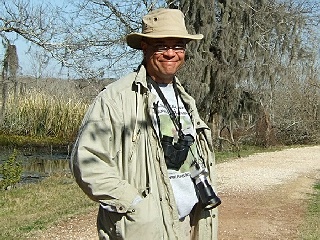
That's
me on the 40-Acre Lake Trail at Brazos Bend State Park
(12/31/2007). I
was waiting for an otter to show up. It didn't.
Over the
years that I've been keeping these pages,
making new observations and learning new things, I have met
some
interesting people.
Two
of them are Dr. Anthony Martin and Dr. Lisa Buckley.
They study ichnology--
animal
traces. While the term is commonly used in relation to
fossils
(such as dinosaur tracks), it also applies to living creatures
as well
(sometimes called "neoichnology"
with "paleoichnology" for fossils). One major
aspect of this study is that such traces can show animal behavior.
For instance, a single footprint might not say much,
except
what
kind of animal made it; but a series them might tell if
the
animal
was running, or jumping etc. There are three basic
factors
that
help to interpret traces: A) Substrate (the
material that holds the
trace) ; B) Anatomy (the part of the animal that affected the
substrate) and C) Behavior (what the animal was doing with the
anatomy
that affected the
substrate). (see "The Three Pillars of
Ichnologic Wisdom" page 9 in Life Traces of the Georgia
Coast
by
Anthony J. Martin) I admit that I am not very good at
finding
and
interpreting
such traces. But, it is still fun to look and try to piece
together the
mystery of what transpired at that spot before I got there.
I
usually capture images of animals
activity. But every now and
then I've taken pictures of traces. I'll begin
collecting
them
here. I will eventually arrange them in chronogical
order of
some
kind. Many, many
thanks to Dr. Martin and Dr. Buckley for many
conversations via email and online; and for being supportive
of my
amateurish efforts.
One
more
thing: Although alligator burrows (or dens) and nests would be
considered ichnological traces. I've only got one example of
an
alligator den on this page. I have
many observations of alligator dens, and have already gathered
them onto other
pages, starting here.
This page is arranged with the newest entries at the top.
At
Scobee Field on 10/16/2021
I found this burrow, and it had water in it. I had a brief
view
of something moving in the hole, and took some pictures of a
crawfish's
face before it submerged
but they didn't come out very well.
But at least I knew that the hole belonged to a crawfish. For
the next
40 minutes, I stalked the hole, and caught some pictures and
short
video
of the crawfish. From the size and color (and location) I assume
that
this was a Red Swamp Crawfish (Procambarus clarkii). Even though
the
burrow was in a ditch,
there was no chimney, but if there was one, it had probably been
crushed by the machinery that left tracks in the mud.
I
read a lot of literature about this species of crawfish. There
are
descriptions of their physiology and their tunneling
behavior. In "Burrowing activity of Procambarus
clarkii
on levees: analyzing behavior and burrow structure" by Phillip
J.
Haubrock . Alberto F. Inghilesi . Giuseppe Mazza . Michele
Bendoni .
Luca Solari . Elena Tricarico (2019)
I found a brief reference
to "the typical sideway position used in this species to breathe
air
oxygen outside the water" .
In "Procambarid Crawfish: Life History and Biology W. Ray
McClain and Robert P. Romaire (2007)
"For
unknown reasons, some individuals will not burrow as the habitat
dries,
while others will construct very shallow burrows that can
quickly dry
out and lead to death." "Crawfish burrows
are usually
dug by an individual crawfish, with the burrow diameter
determined by
the size of the crawfish. The burrow extends downward into a
terminal
chamber that is slightly larger than
the diameter of the
tunnel." "it is thought that any free water in a burrow is
likely to be
trapped water, perhaps from rainfall seepage, rather than water
seeping
into the burrow from the water
table. When there is no standing water in the burrow, wet
mud
in the chamber serves as a humidifier."
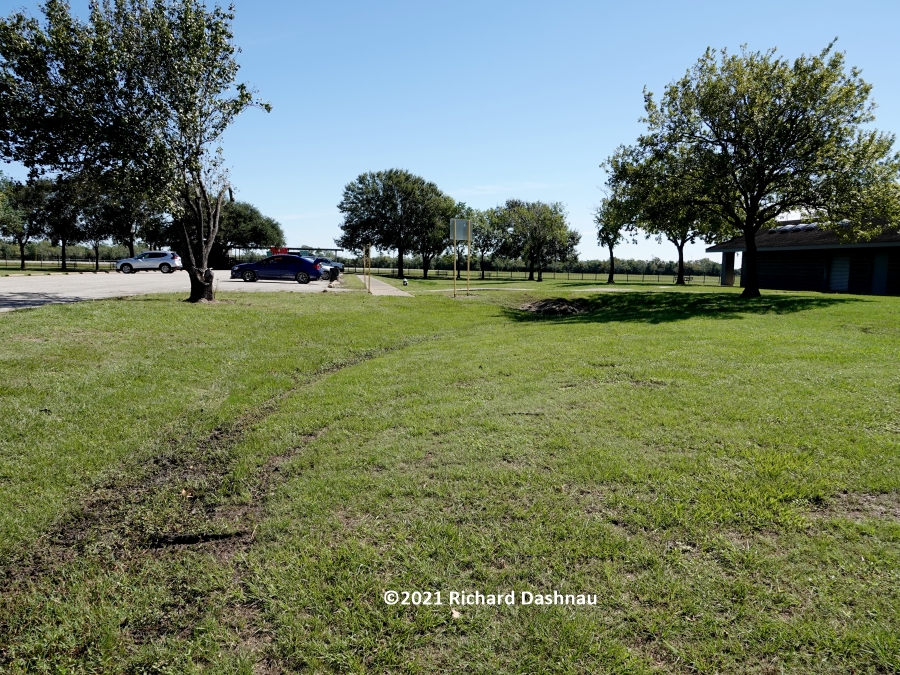
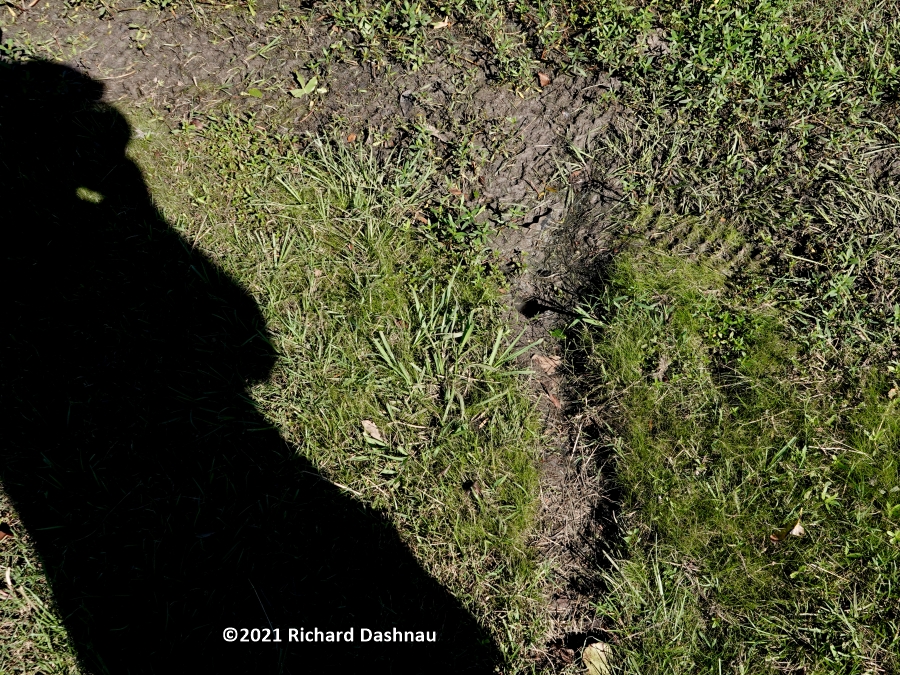
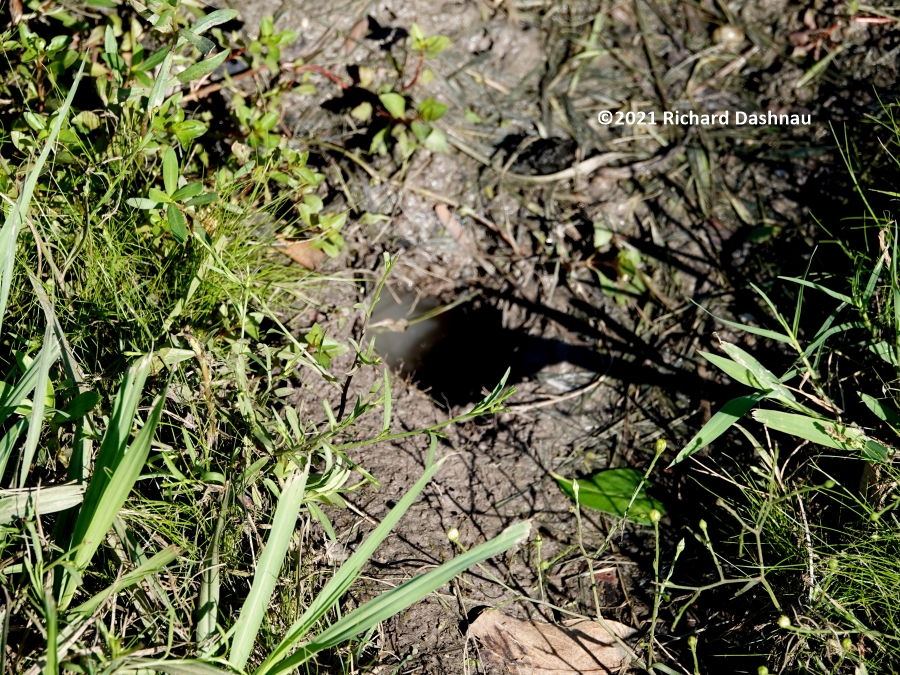
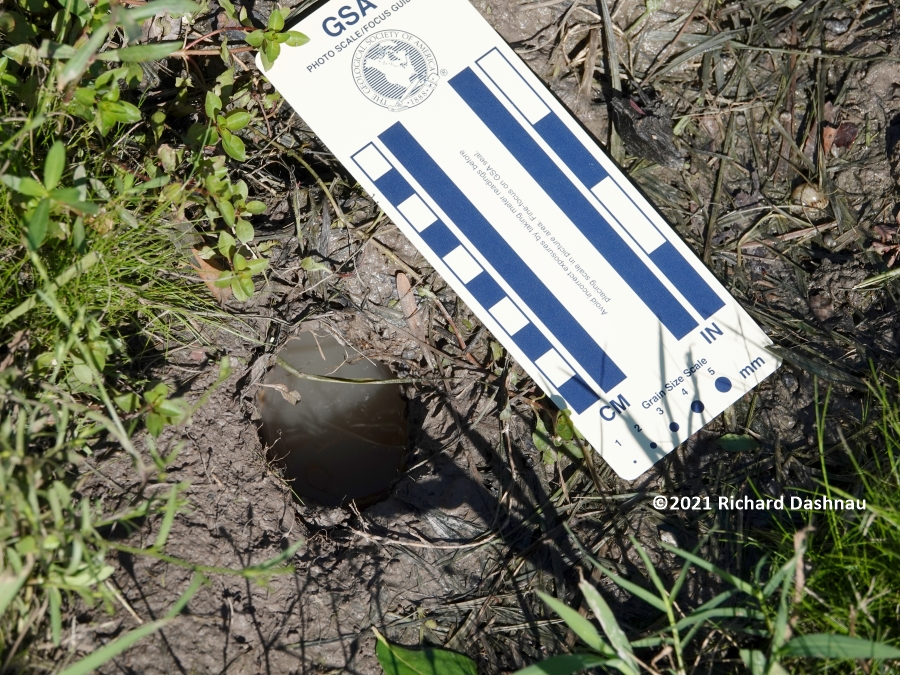
In
"Gill
Morphology in the Red Swamp Freshwater Crayfish Procambarus
clarkii (Crustacea: Decapoda: Cambarids) (Girard 1852) from the
River
Nile and its Branches in Egypt: by
Mohamed M. Abumandour
(2016) describes: " From available literature, it is well known
that
there were special anatomical characters of the respiratory
adaptations
of crustacea to
terrestrial and amphibious life, in which the
crayfish can live for weeks in burrows without free water and
adapt to
survive for long periods of hypoxia that occur within this
burrows due
to the
large surface of respiratory gill area." The crawfish
exposed its side to the air, in a "breathing posture". In
the
closeup, there are feathery structures visible at lower edge of
the
carapace,
where the legs are attached. I think these are
sections of the gills, specifically the "podobranchiae" one of
three
types of gill structures possessed by crawfish. ("The red swamp
freshwater
crayfish possess a trichobranchiate gill type, which
consists of three types according to their place of attachment
on the
body; podobranchiae, arthrobranchiae and pleurobranchiae." from
Abumnador
2016). With such an abundance of gill tissue, crawfish can move
around
in air for some time-as long as the gills are kept moist.
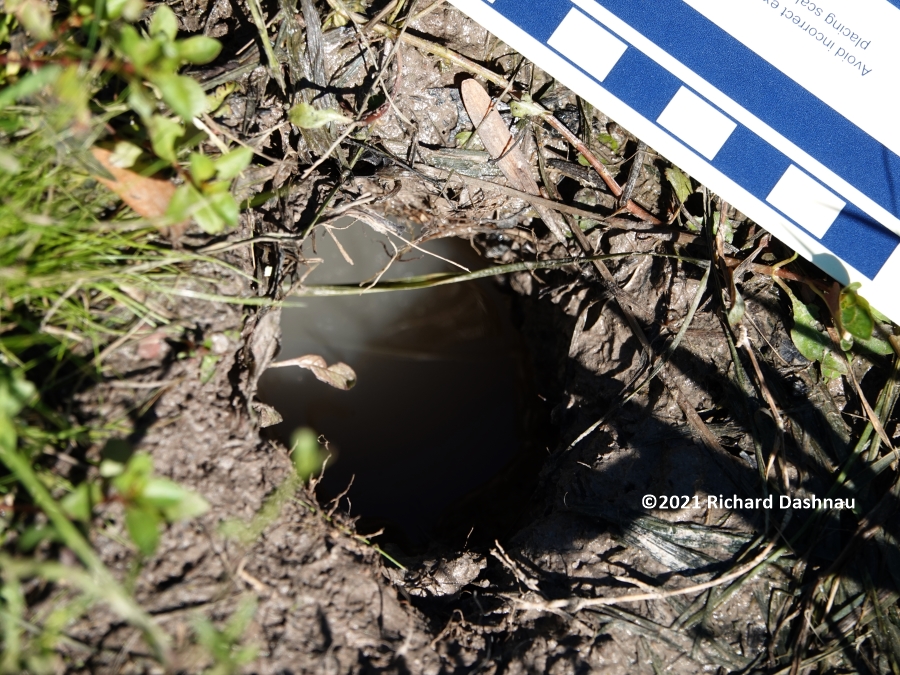
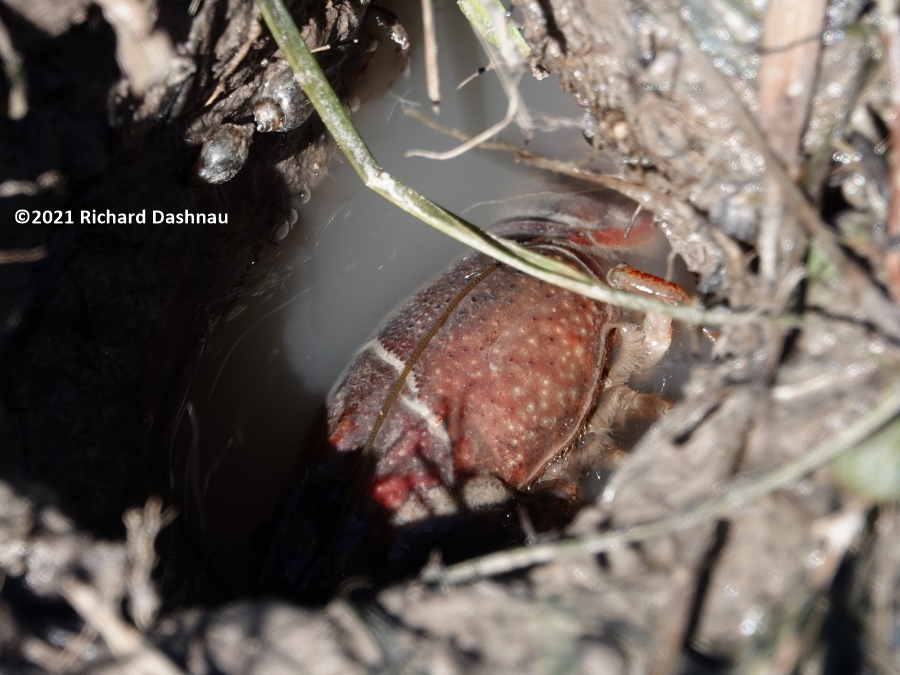
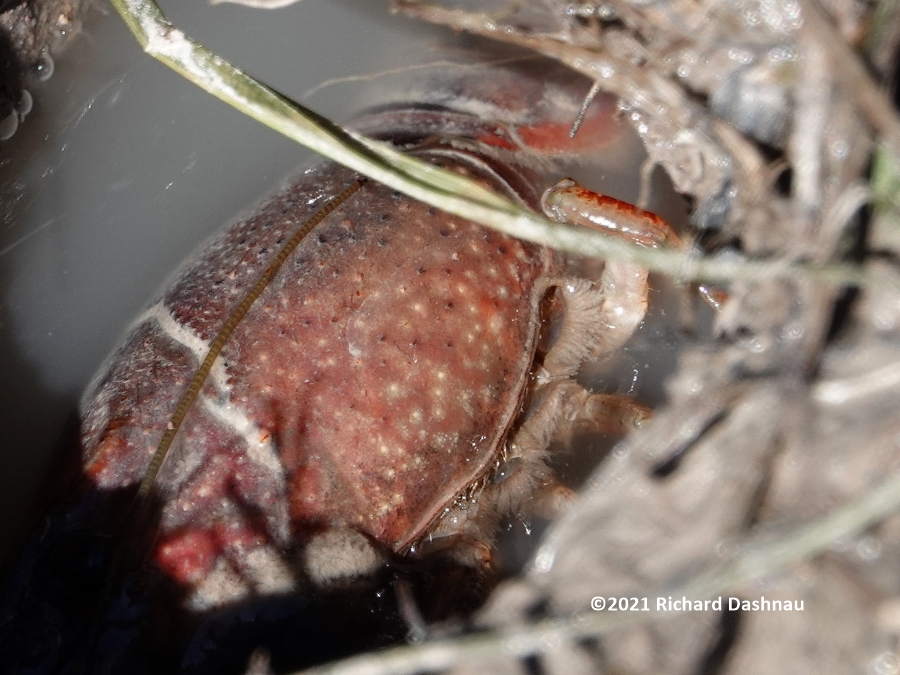
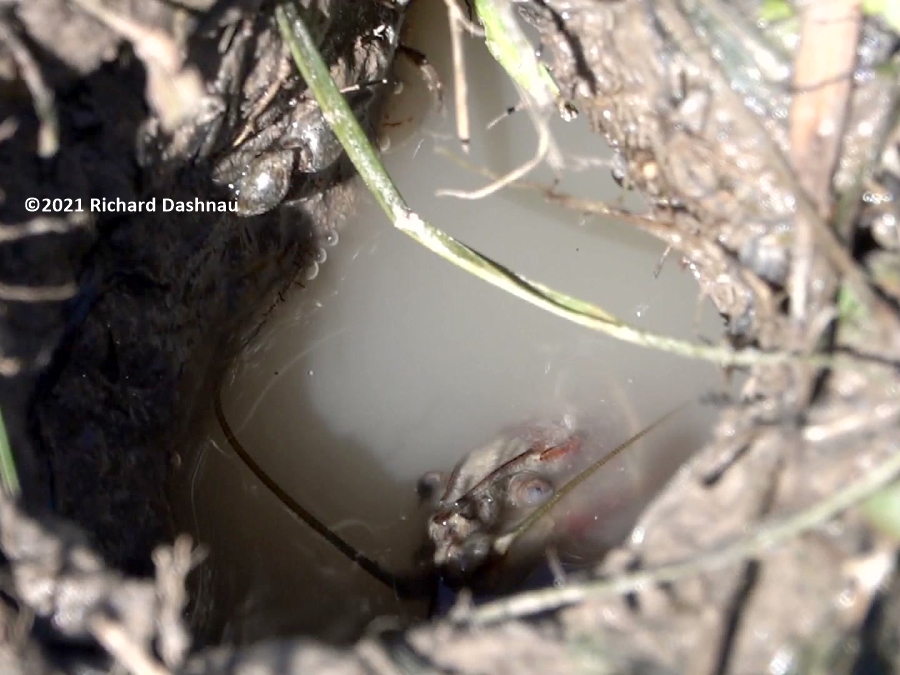
I
had to walk away from the burrow, then move back slowly, and
then use
telephoto shots to catch the crawfish unawares. I got a few
shots of
its face before it backed under the water.
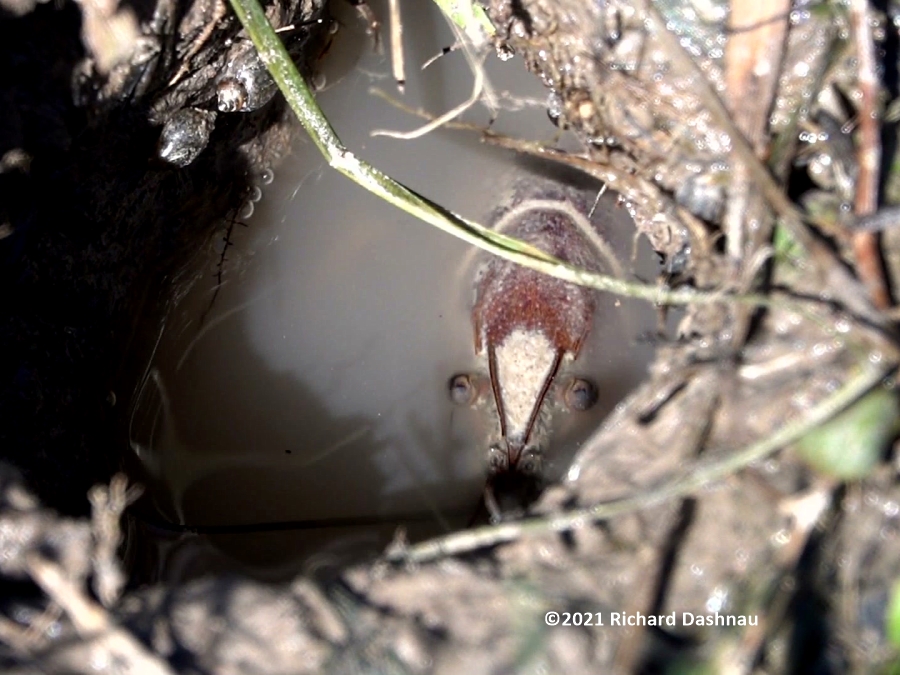
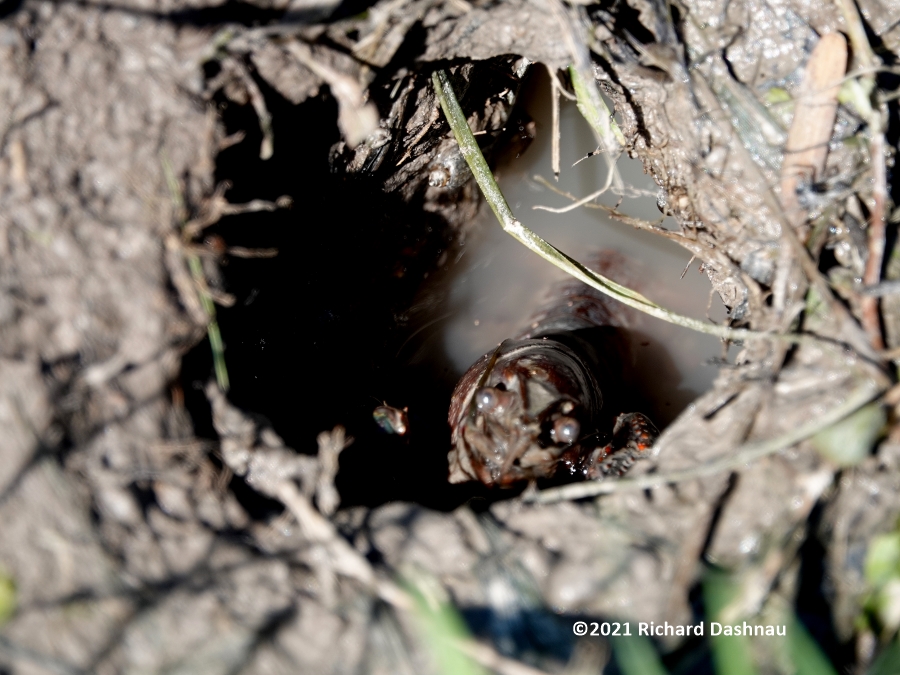
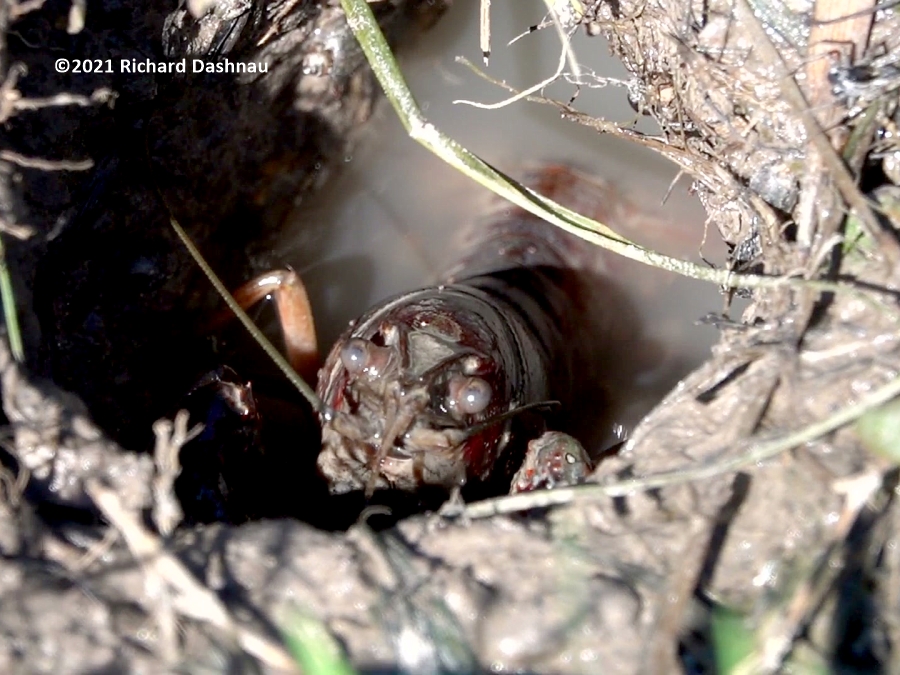
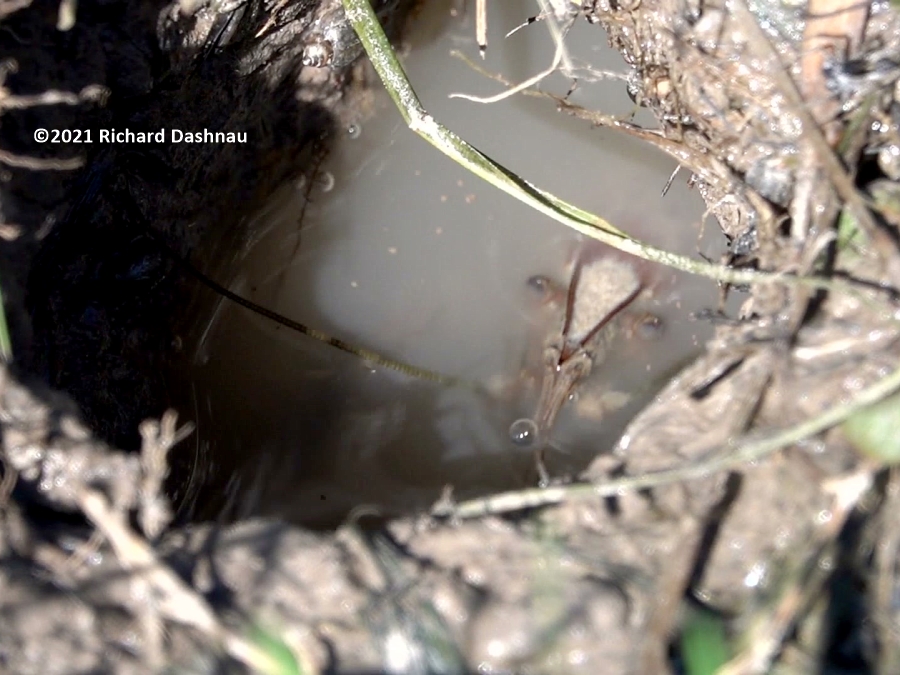
These
pictures of Scobee
Field from 10/02/2021-- 10/09/2021 show how the water levels
can change at the park. Since Scobee Field is inside
Barker
Reservoir, it is going to flood if we
get
enough rain. After all, Barker Reservoir was built to collect
water and
control it to avoid flooding Houston, which is East of this
area.
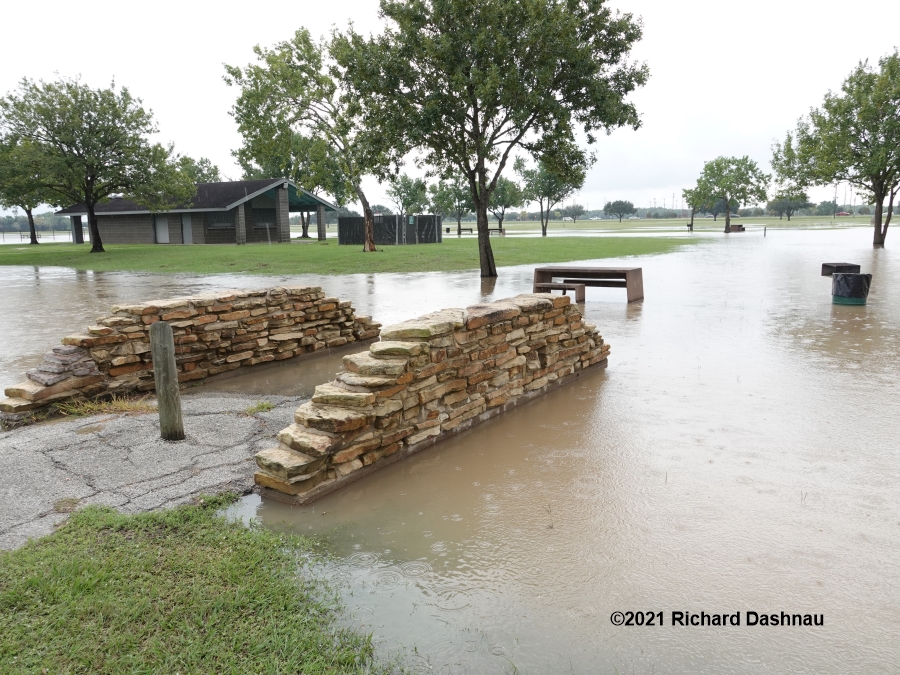
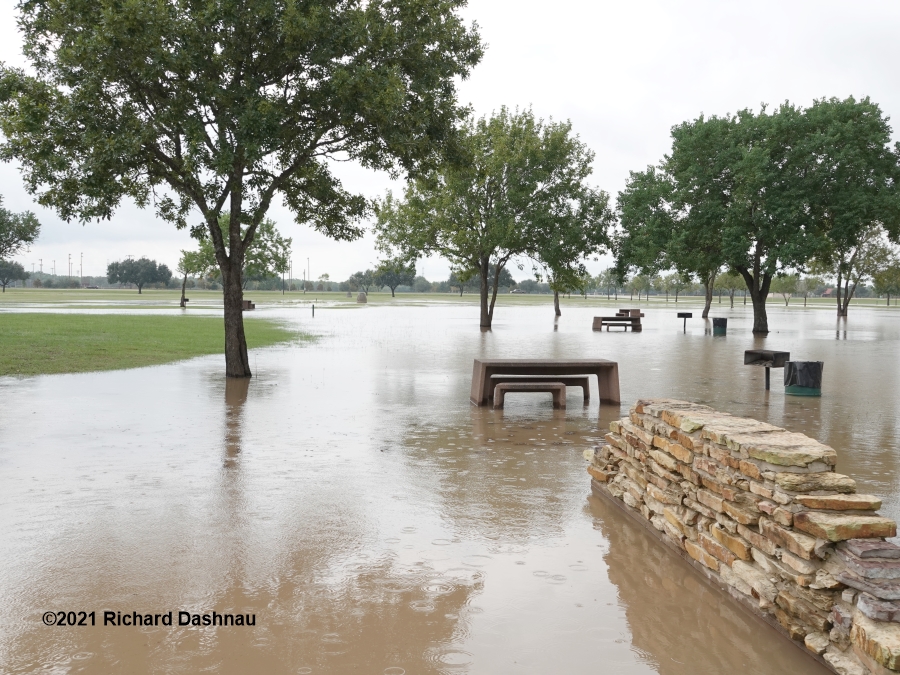
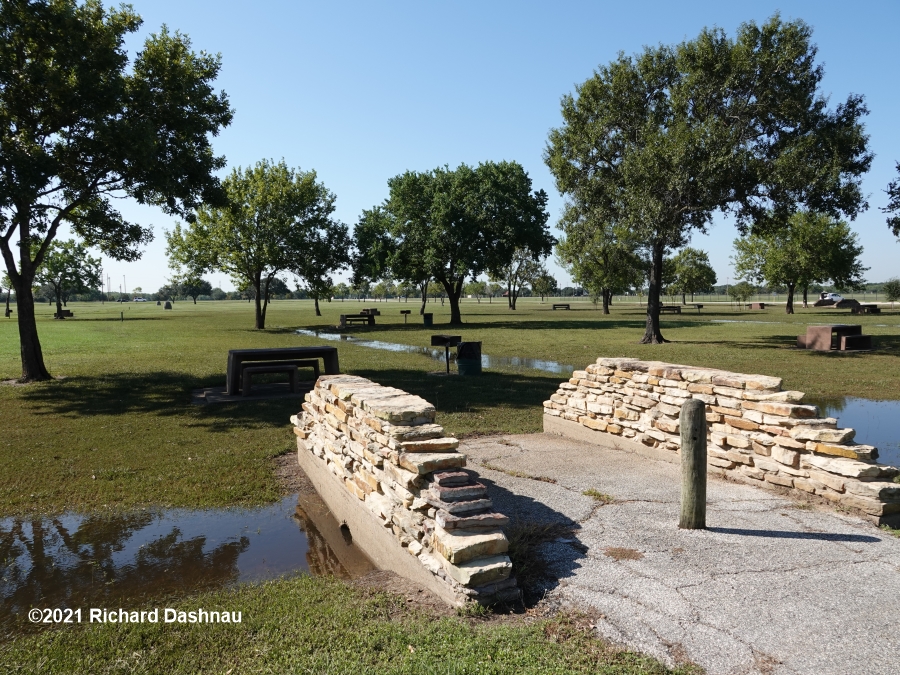
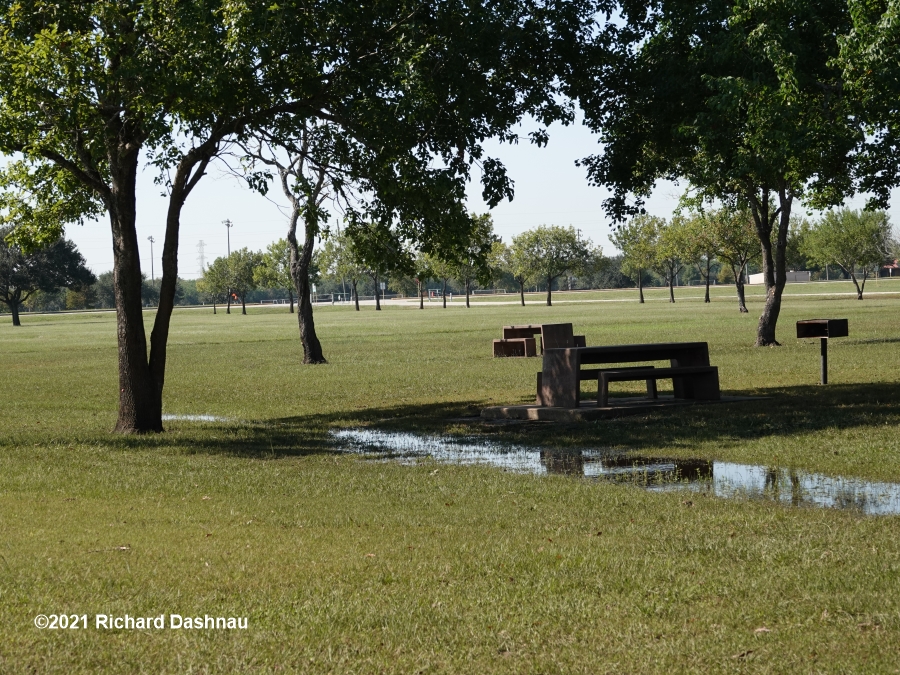
10/02/2021
10/02/2021
10/05/2021
10/05/2021
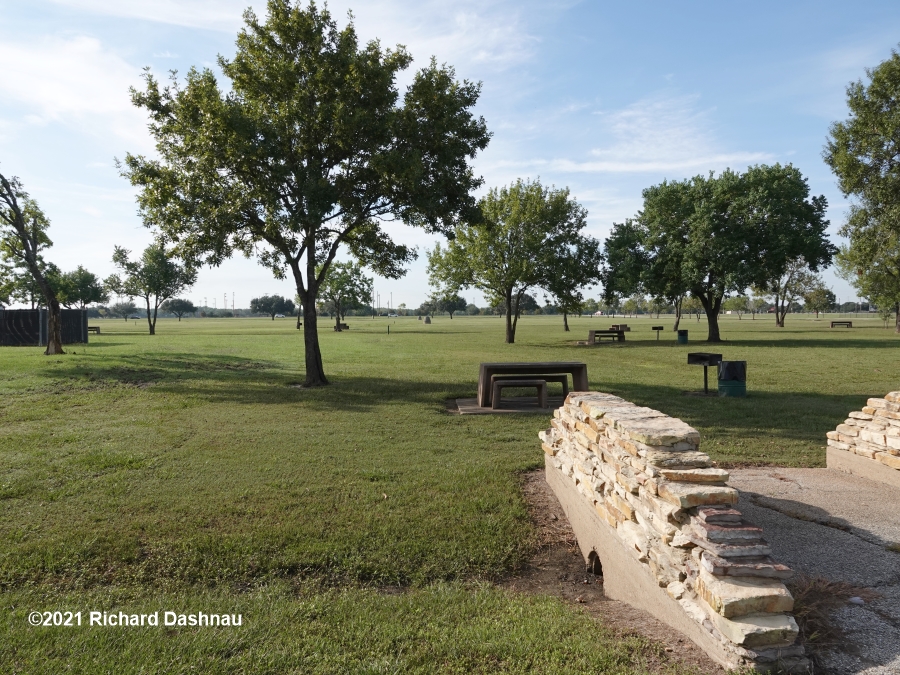
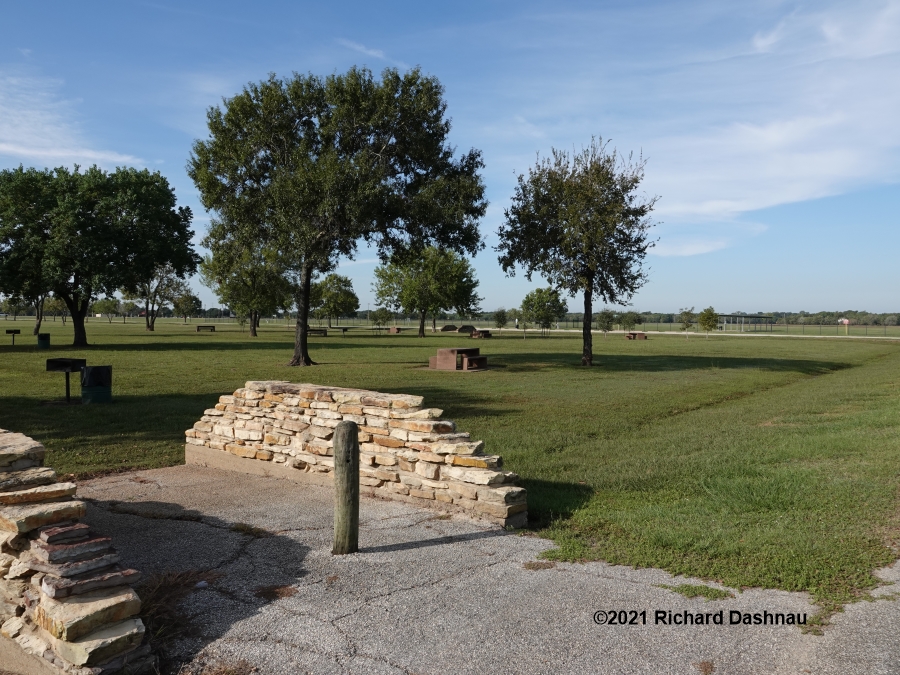
10/09/2021
10/09/2021
At
Scobee Field on 9/25/2021--
inside of Barker Reservoir .This time, I
investigated
one of the larger holes. This one was about 2.5 inches diameter.
When
I
tried to get pictures of the inside, I found a cricket, but
obviously
that was just borrowing the hole. I used a folding ruler to
measure the depth, and had to bend the ruler slightly.
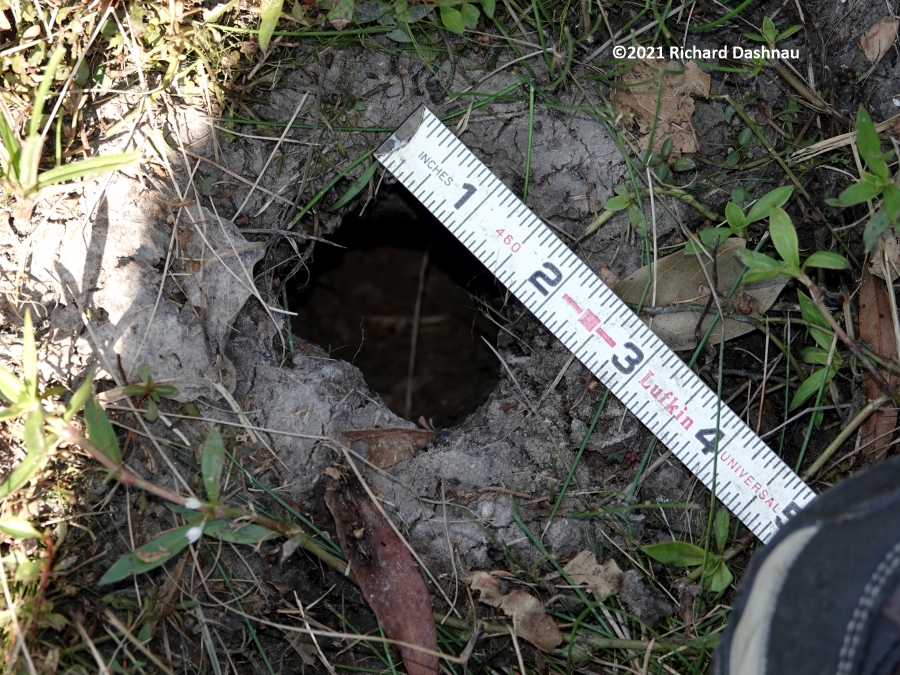
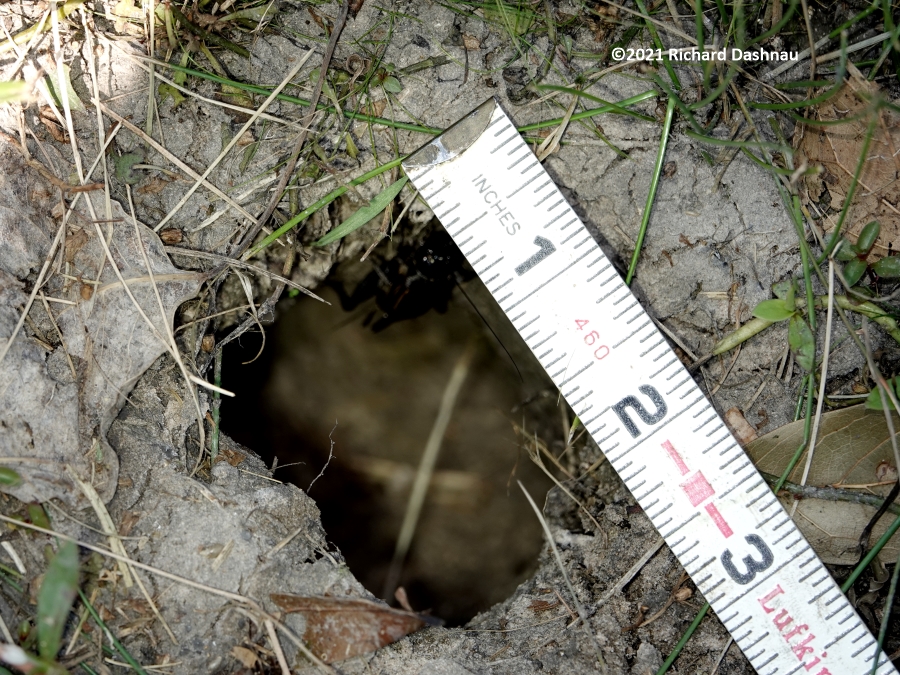

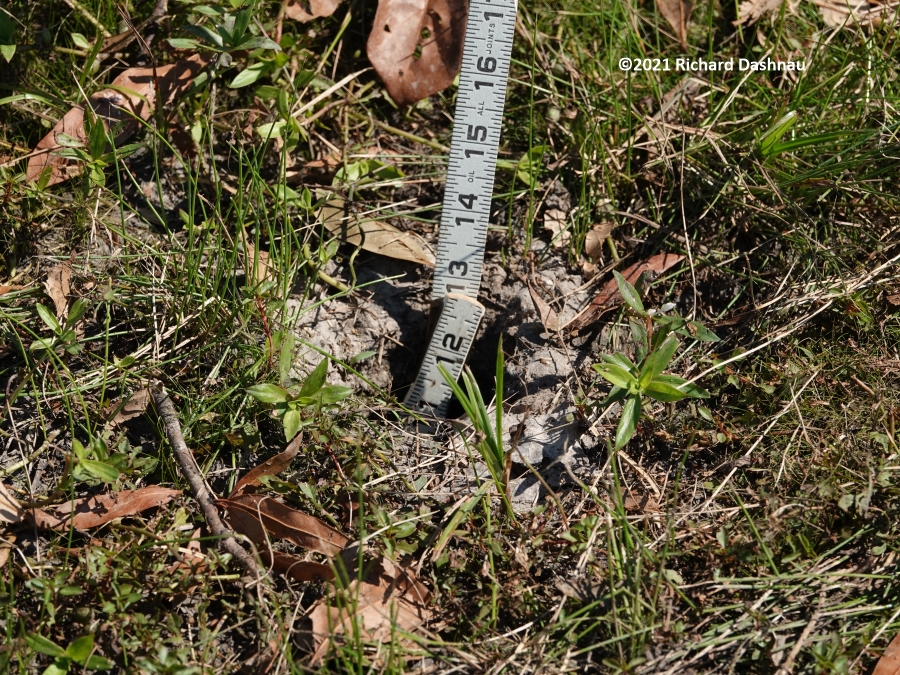
Multiple
samples got me a
burrow length of 13 inches. The
sides of the burrow were worm smooth, and dry. The
cricket
had already demonstrated that the walls were good climbing
surfaces.
I
decided to try to fill the burrow with water, to see if I was
looking at a hole, or a tunnel. I found a discarded 32 oz cup. I
could
only fill it about halfway because of the water fountain. I
filled the
hole, using 3 "half cups", so maybe a quart and a
half.
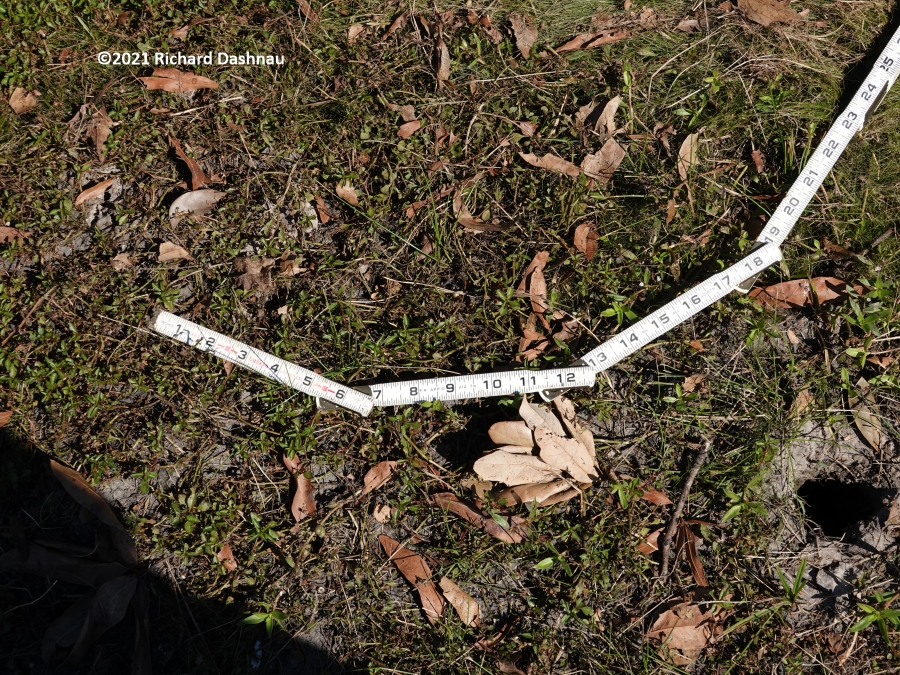
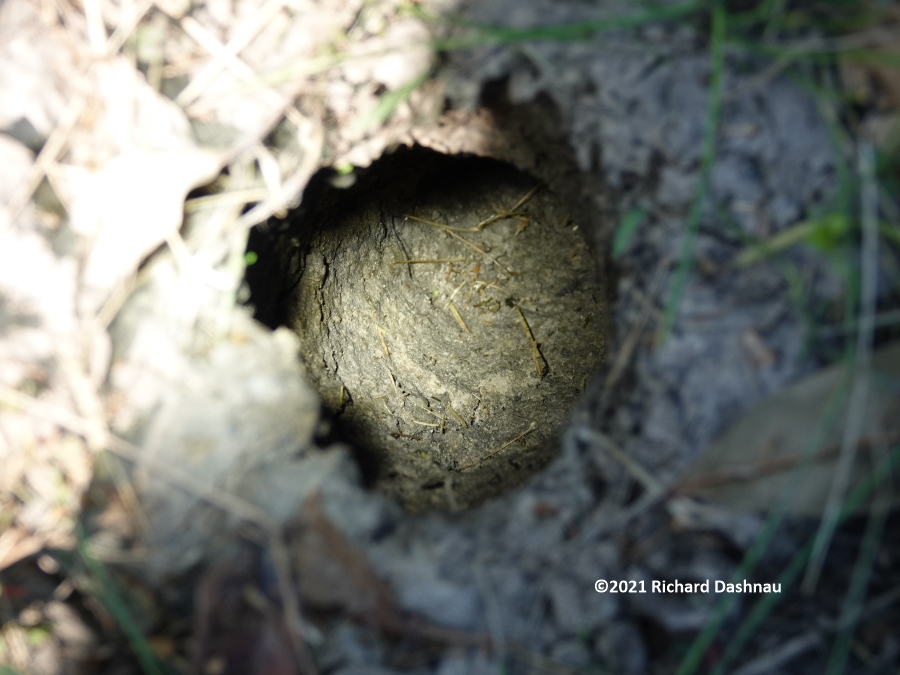
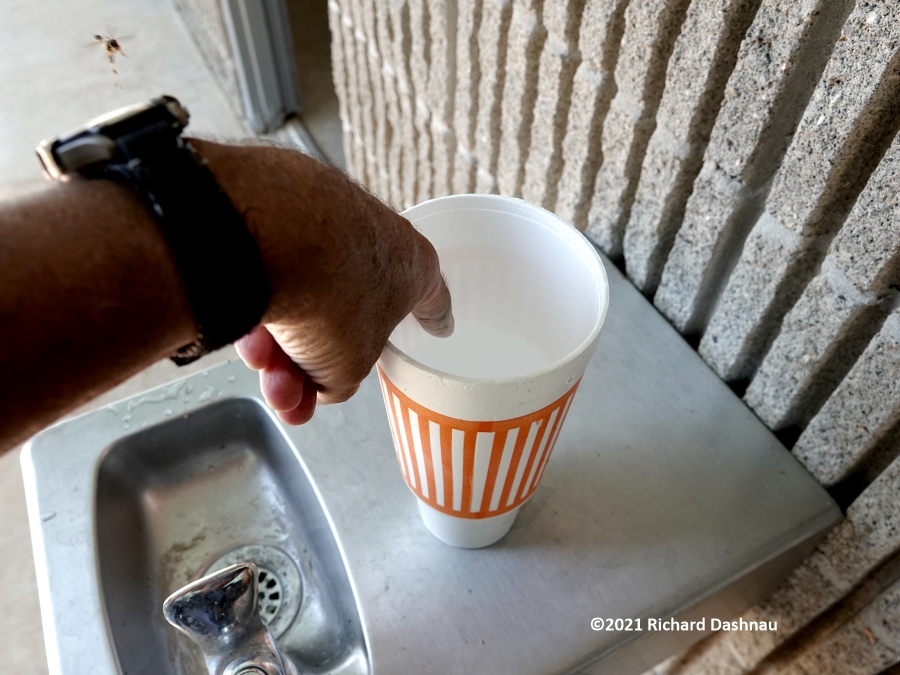
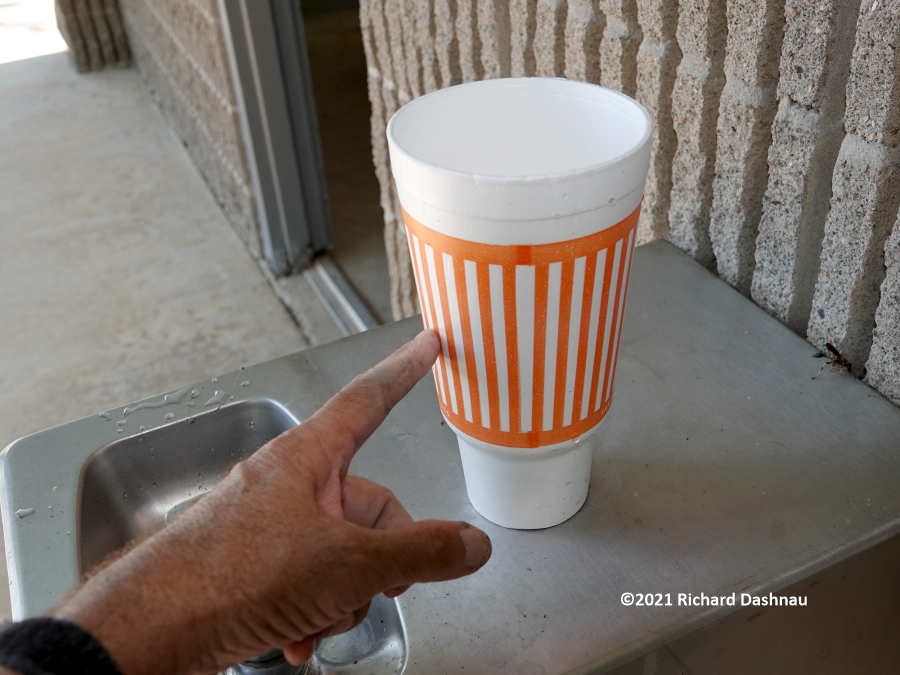
I did fill
the hole, though, so it appeared to be closed at the end. It
emptied
slowly, so water did seep
out from somewhere. After about 3 minutes, when the
level dropped
4 inches I refilled
the hole, and then watched to see if anything would
come out. I
expected a crawfish, even though the opening was about 2x larger
than
most crawfish burrows I've seen. This time it took
about 10
minutes to go down 4 inches. Refilled again--12:06
The water level dropped slower.
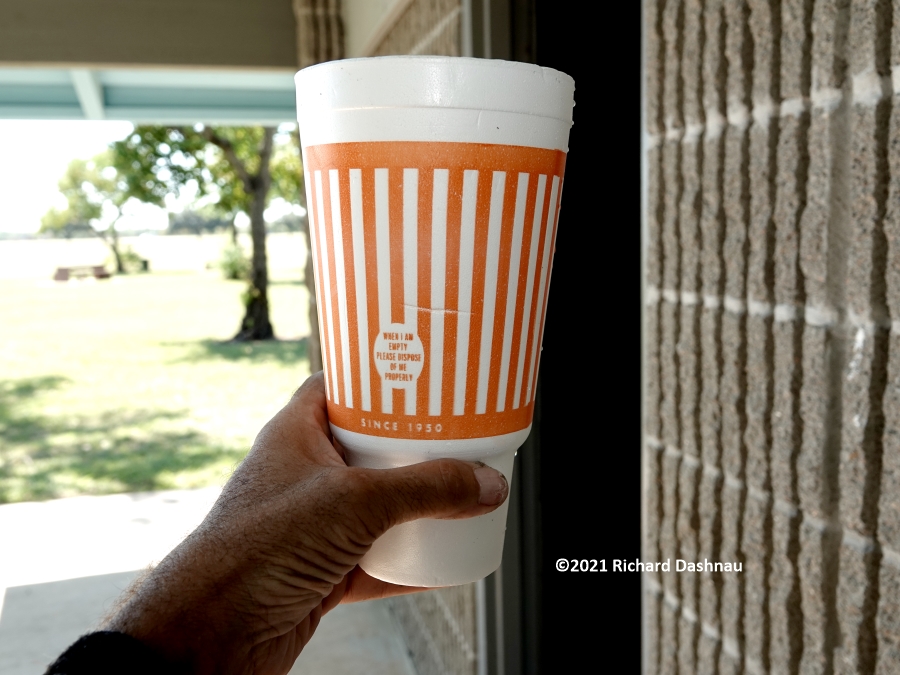
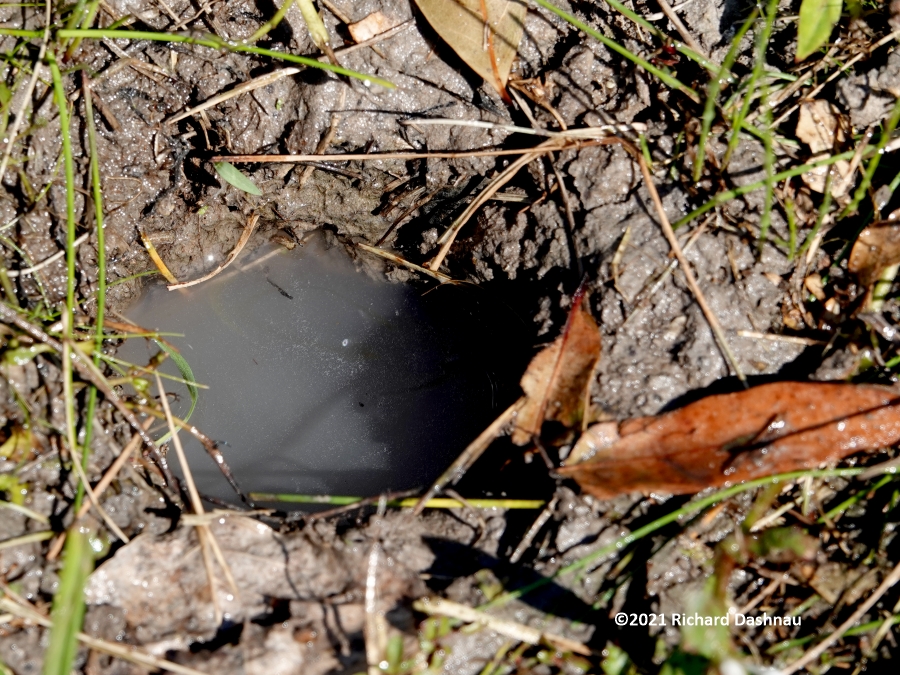
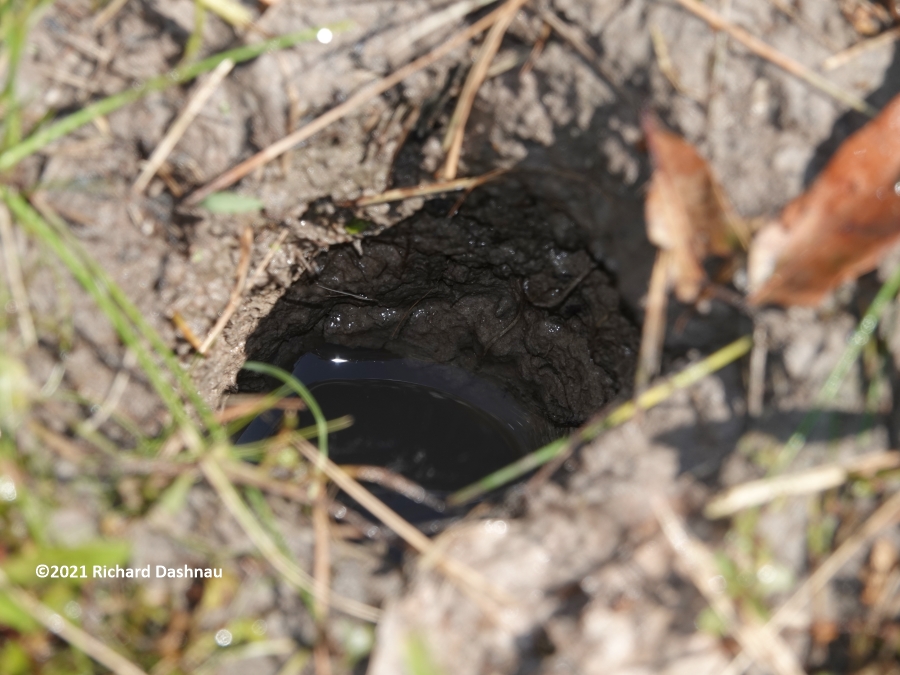
Then,
about 12:12 (6 minutes
after filled), I got a surprise. A Gulf Coast Ribbon Snake
(Thamnophis proximus) poked its head out of the
water. I stood still
and
watched as it checked
to see if the coast was clear. It went back
under the
water...then came back up. I stayed and watched. I stayed
motionless as the snake slowly crawled out of the hole. It
stopped once
to "yawn", or maybe to readjust its jaws.
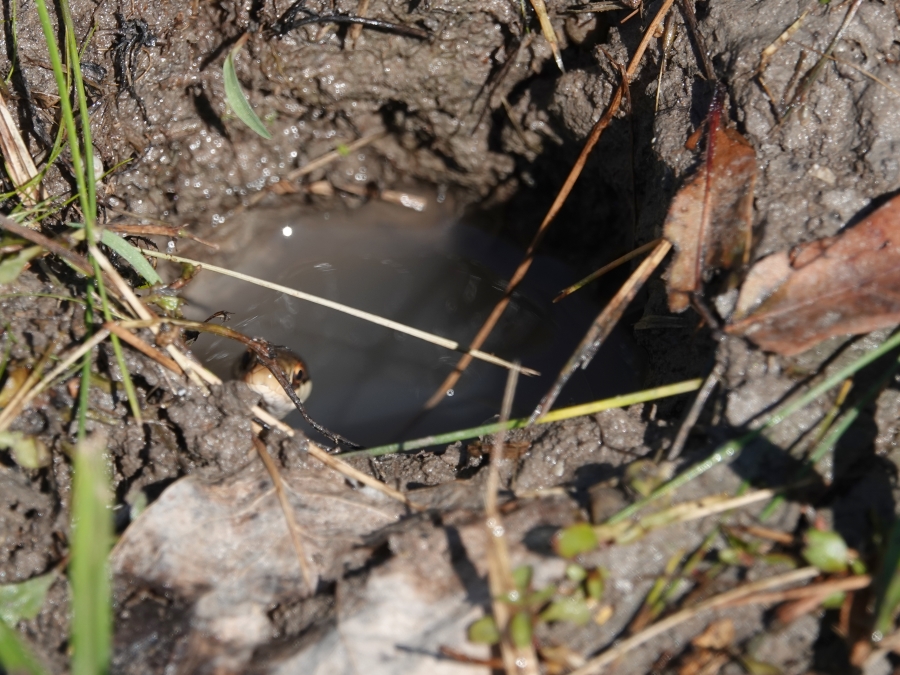
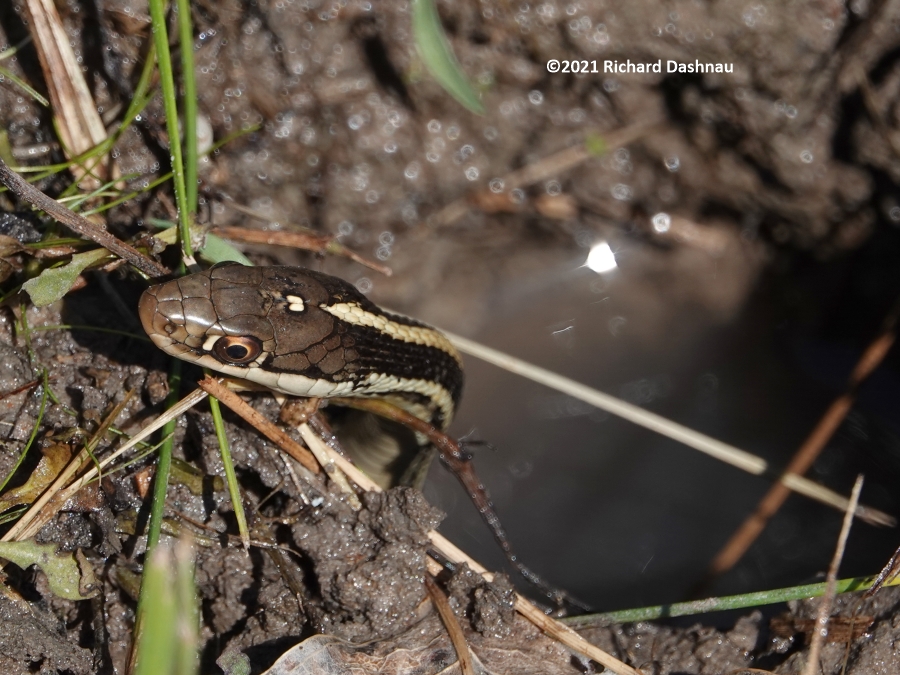
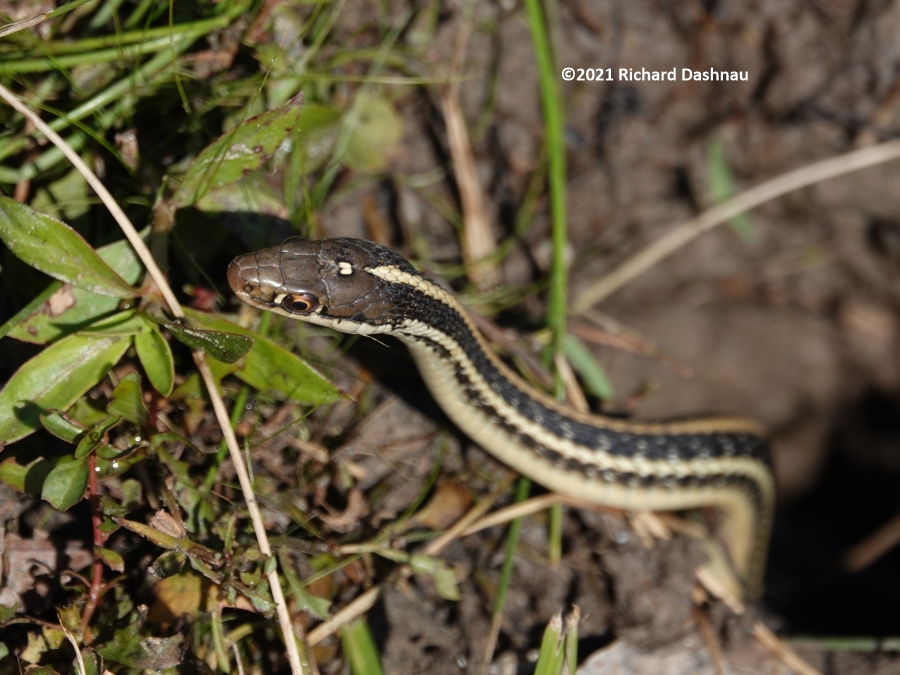
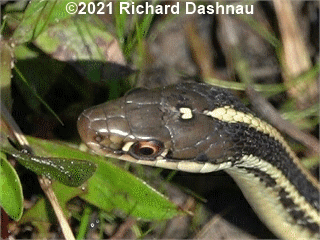
I
felt a bit sorry, since I'd flooded the snake's hiding
place-although I
hadn't known it was in there-because I didn't know where it
could
go. There
was little cover around
that ditch.
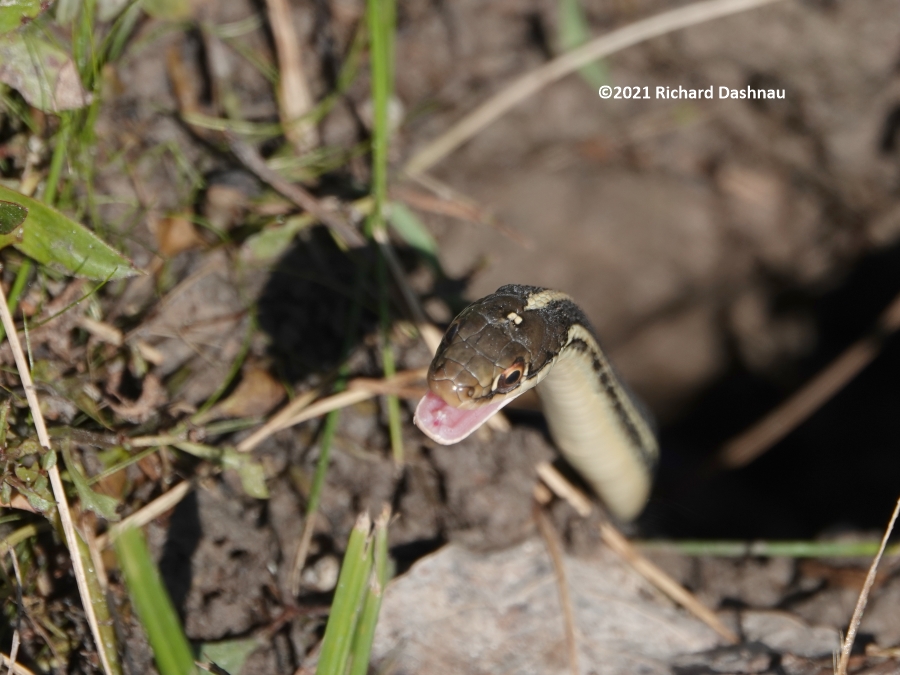
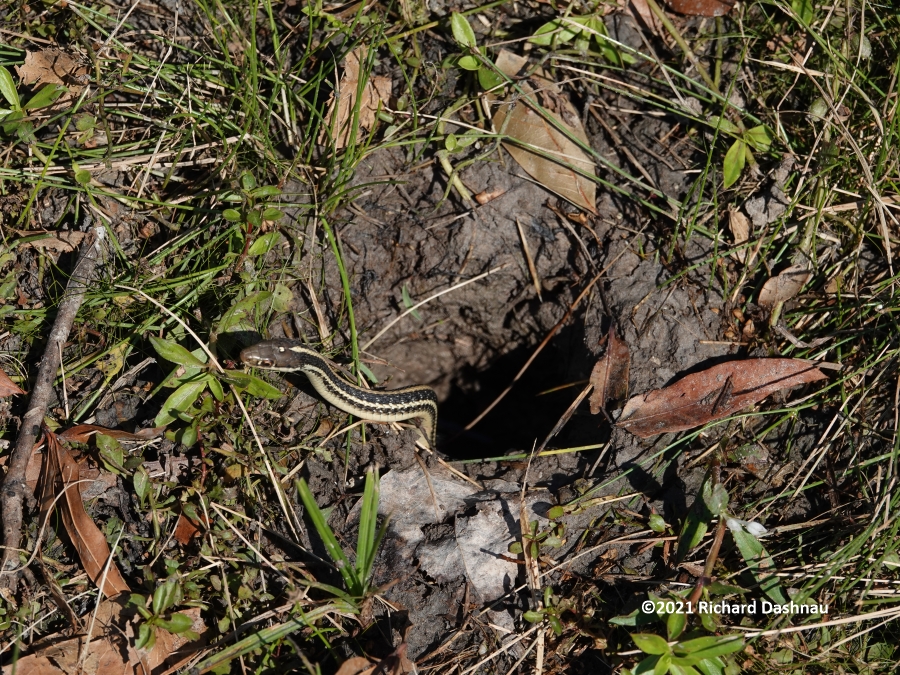

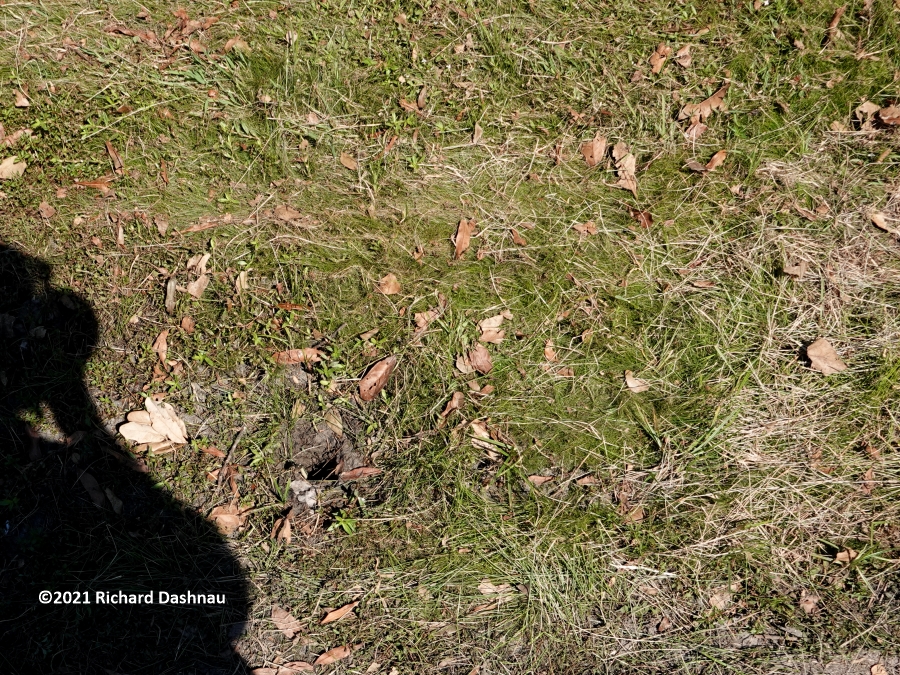
The
snake
decided
it was safe to move. It got out of the hole, and
then...disappeared under the grass. I was totally surprised at
how
easily it disappeared! I never did find out what
might
have made the hole. I thought that it might have
been a snail's
burrow, and had slight hope that it might come out, it didn't
happen
before I left.
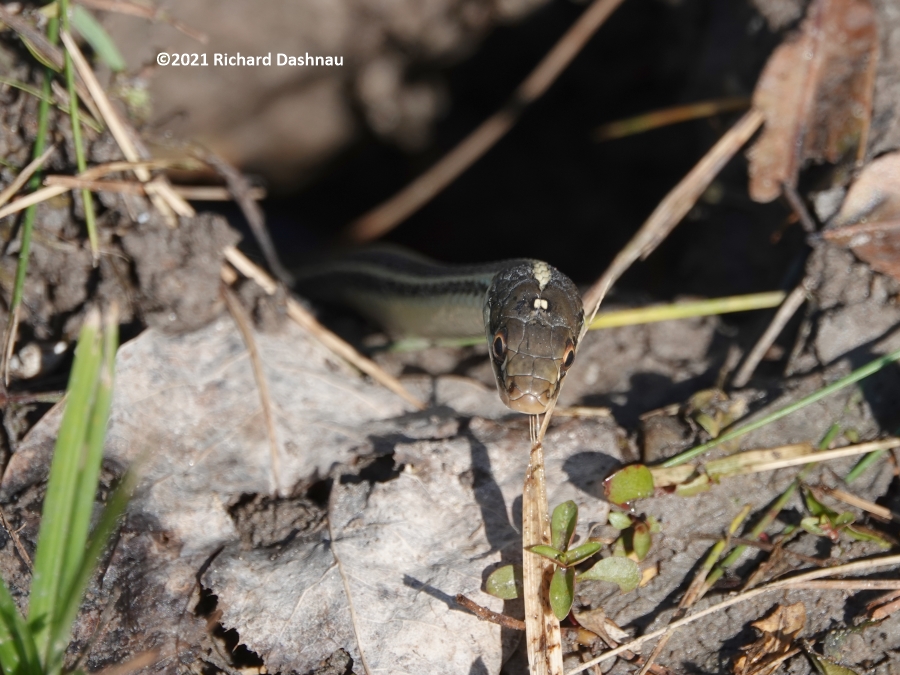
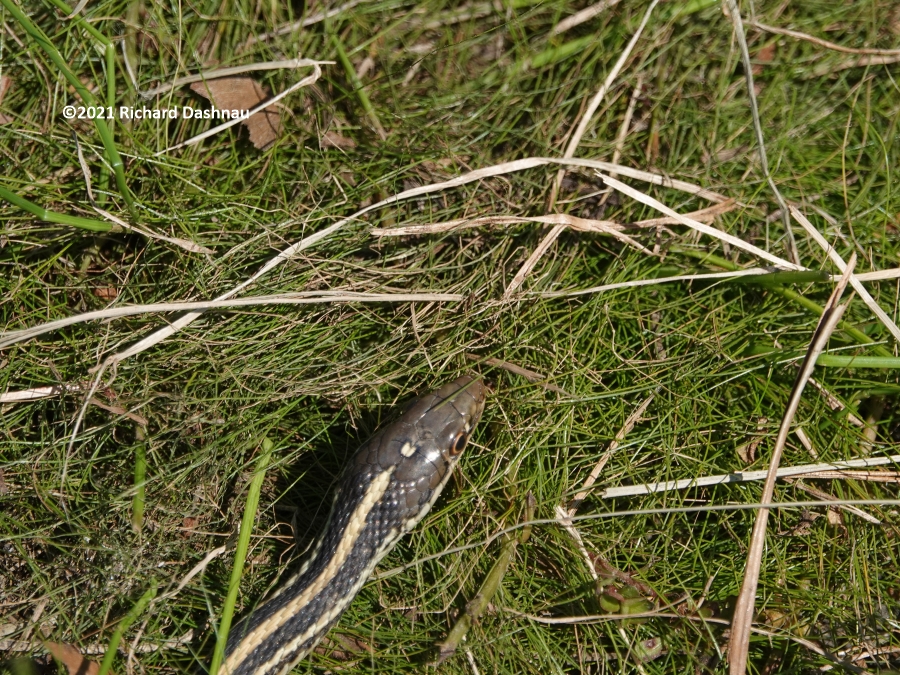
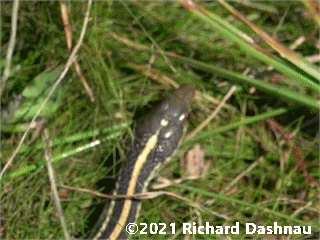
I
tried a little geometry to figure out the size of the hole,
by using
the formula for the volume of a cylinder: V = πr²h
Hole diameter was 2.5 inches so radius = 1.25
Depth was
approximately 13 inches. So: V =
πr²h
3.14159*(1.25*1.25)13
= 63.813 cu.in. BUT the
measured volume was
1.5 quarts = 86.625 cu in
So I did this: 86.625 =
3.14159(1.25*1.25)h and 86.625 = 4.9 *h and
86.625/4.9 =h
and 17.689 = h so the hole should have been
about
17 inches
long (or deep?)
This really doesn't tell me much since I got a
4-inch difference, and can't be sure if the burrow is
symmetrical,
anyway. But it was a fun exercise.
At Scobee
Field on 8/28/2021--The
Scobee Radio Control Flying Field is inside of Barker
Reservoir. It's
about 4 miles West of Fiorenza Park North. The airfield is
within a 65
acre rectangle
(Google
map measurement). There's an 8-acre picnic
area around the main parking lot. Most of the time, this
area is dry;
but sometimes water covers the entire area. I'd started
paying
more
attention
to
the ditches and wet ecology when I learned about apple
snails
(Pomacea maculata); and had found them at Scobee.
While
walking the ditches, I saw many burrows about 1 inches
across which I
assumed to belong to crawfish. But there were also other
burrows that
were about larger--maybe 3 inches across.
During
that time, I
also learned that Apple Snail can burrow to avoid adverse
conditions,
and I wondered if the larger burrows could have been made
somehow by
the snails. By the way, although
I
have found occasional
mention of the snails burrowing, I can't find any pictures,
or
diagrams, or descriptions of what the burrows look like. I
*did* find
what seemed to be snails that had made
very
shallow holes-maybe the
beginnings of burrows-but that's all. At various times
through the
summer, I examined some of the burrows in the dried ditches.
Here are
some of them.
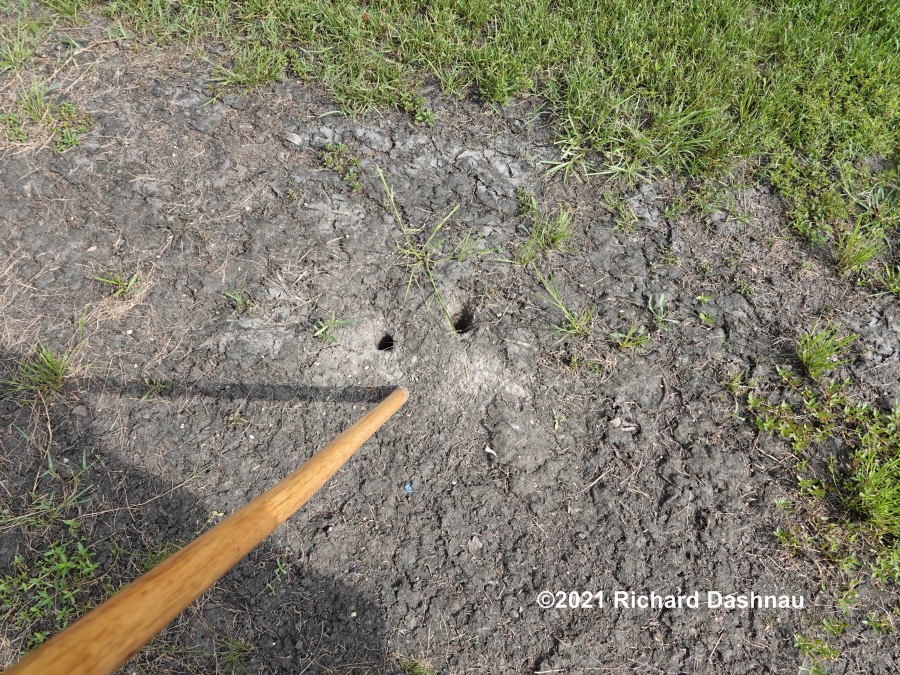
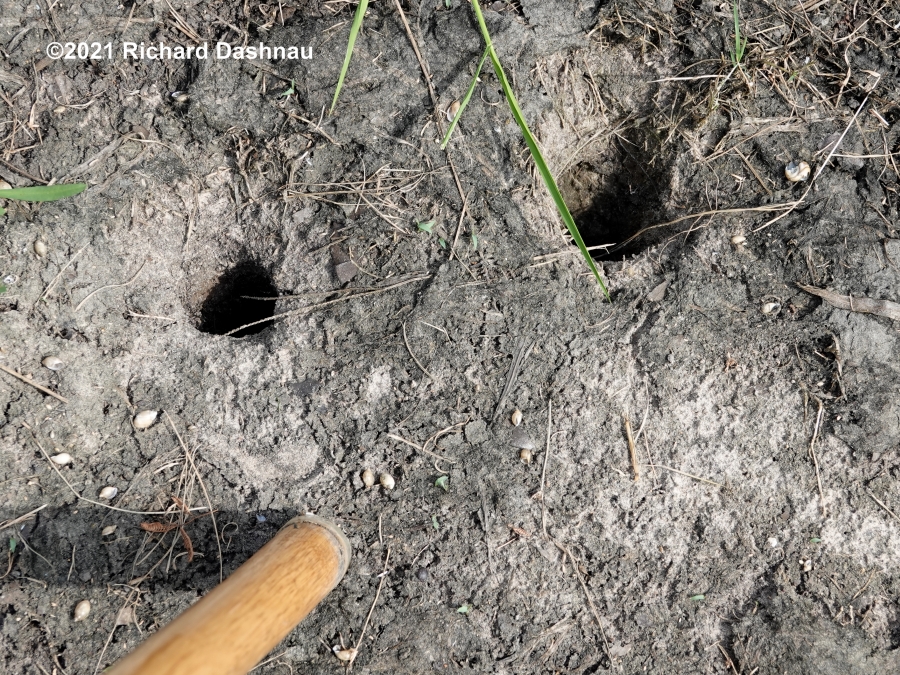
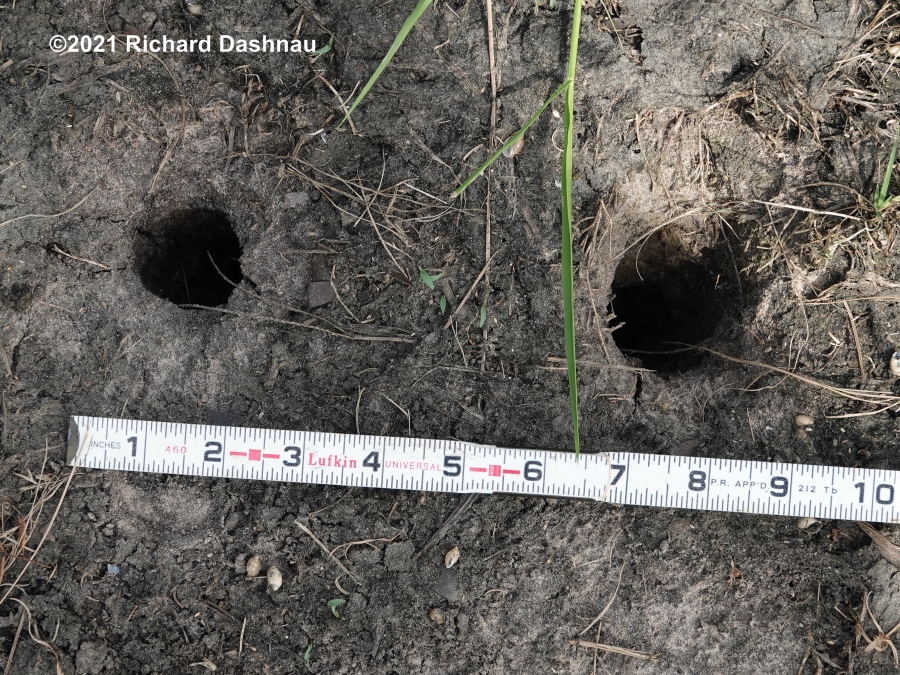

A pair
of holes in the dry ditch
Closer view of the holes
I would call these "crawfish
sized" holes
I tried a depth measurement.
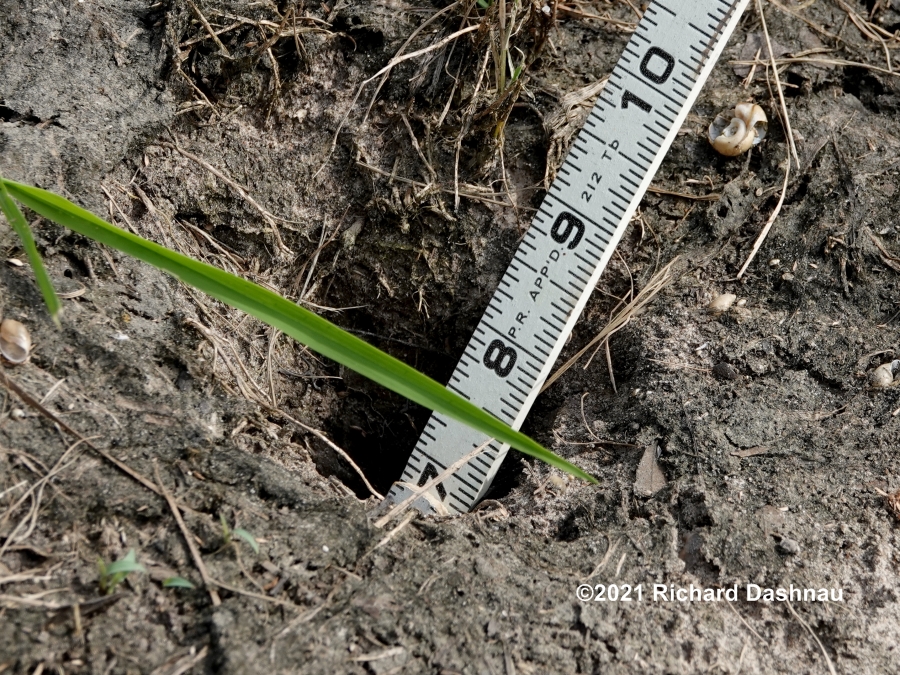
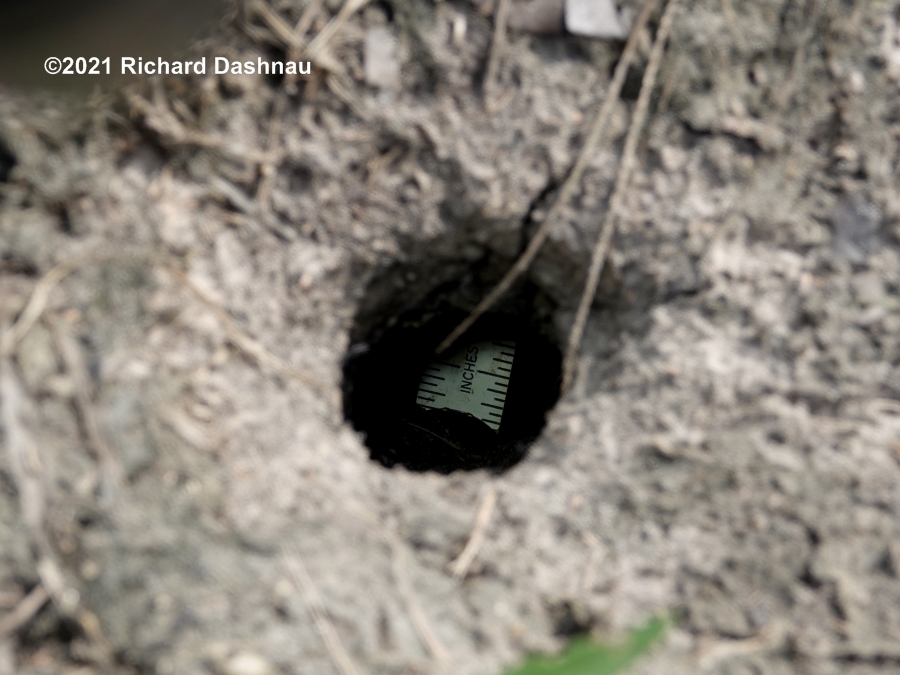
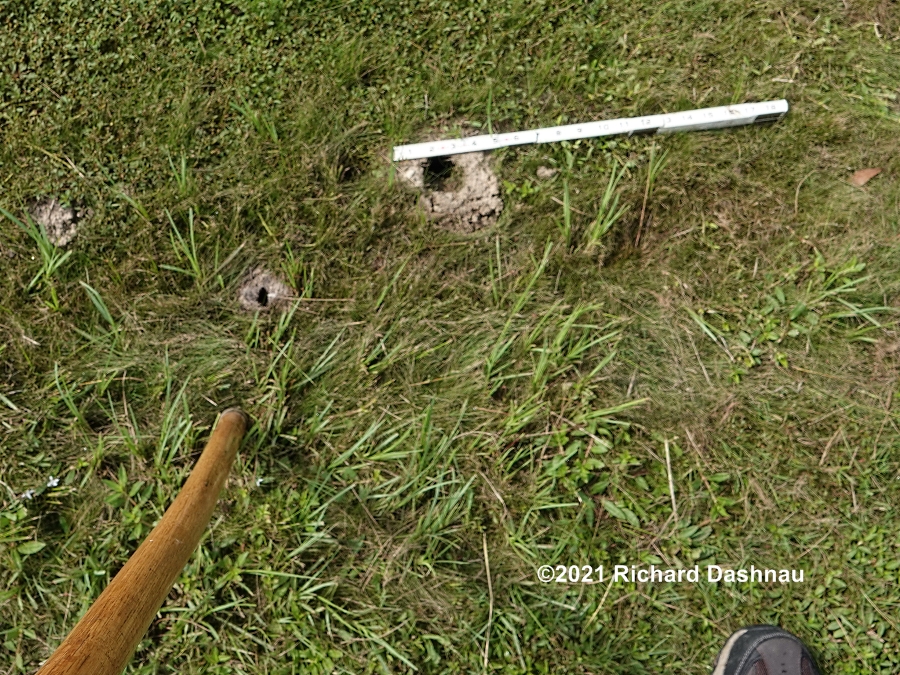
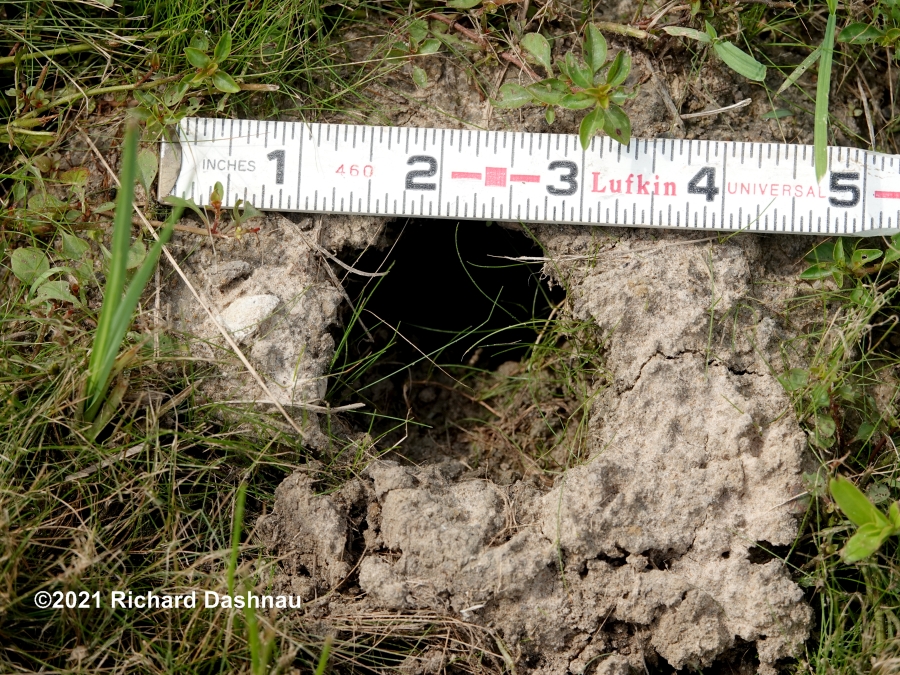
About 8 inches deep.
I could see the ruler from the other
hole. These
holes
showed excavation
traces
About
1 1/2 inches across.
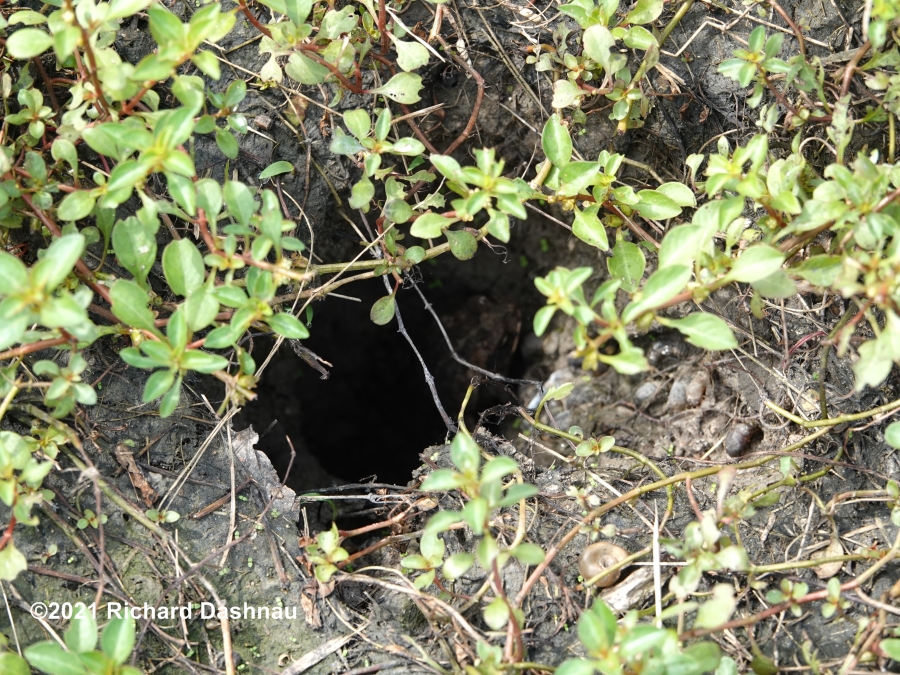
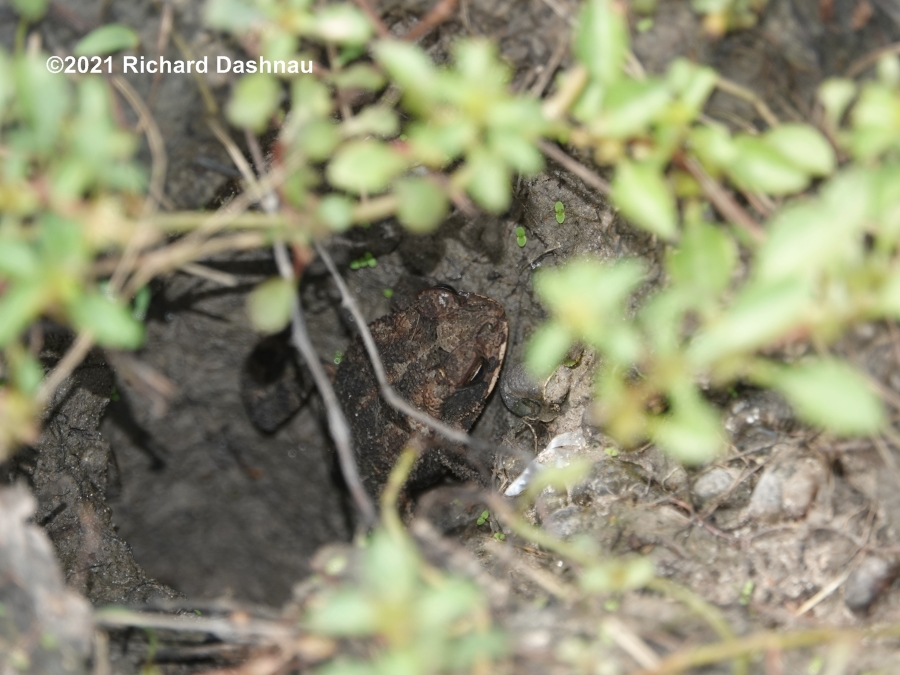
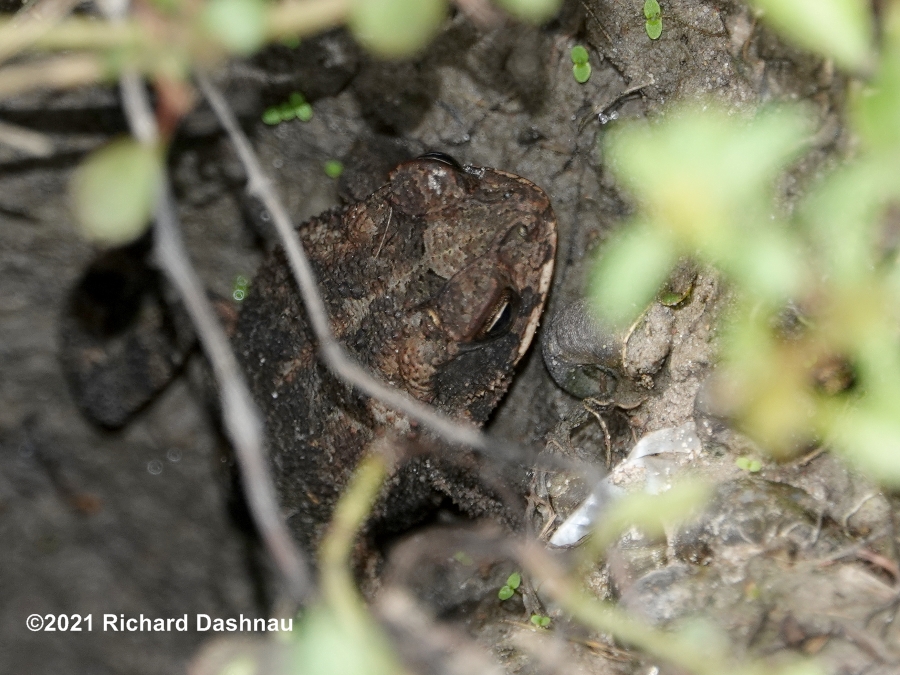
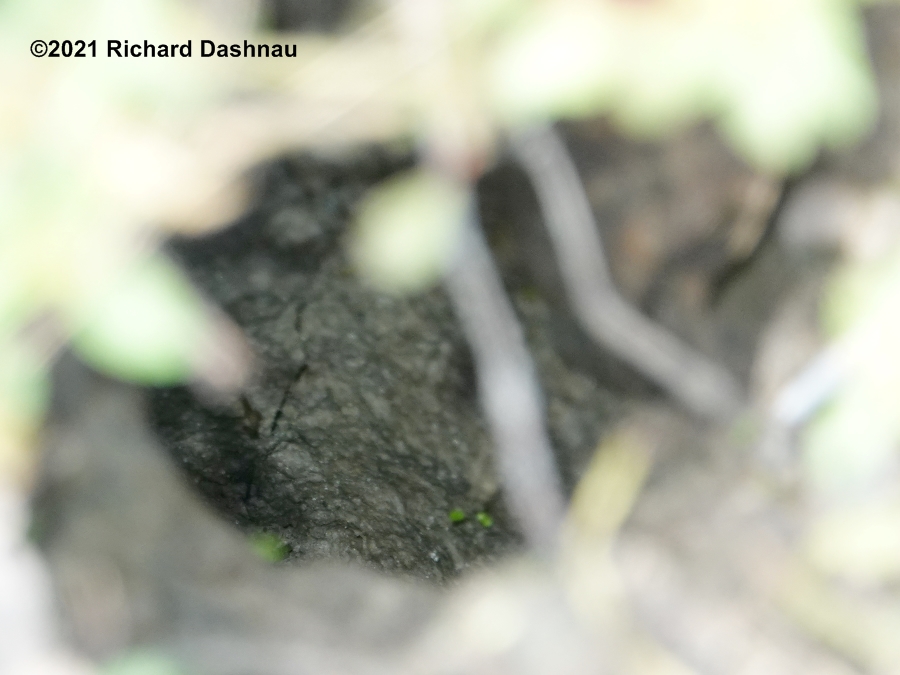
I checked one more large
hole...
....and
this occupant came up
to see me.
I've seen holes dug by toad
before...
...but the toad could have
borrowed it.
At Scobee
Field on 9/18/2021--This
time I found a fresh hole. The ground was soaked well, so
the mud was
soft, and didn't mold into solid pellets for making a
chimney. But I was
able to
get
a quick look at the crawfish's mud-covered face in the hole
before it
dropped out of sight.
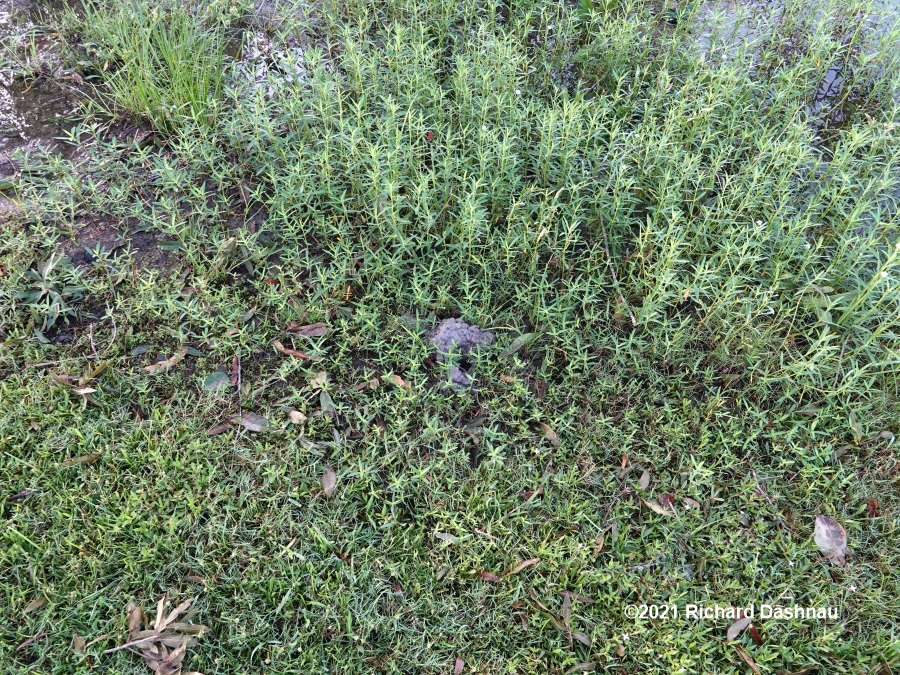
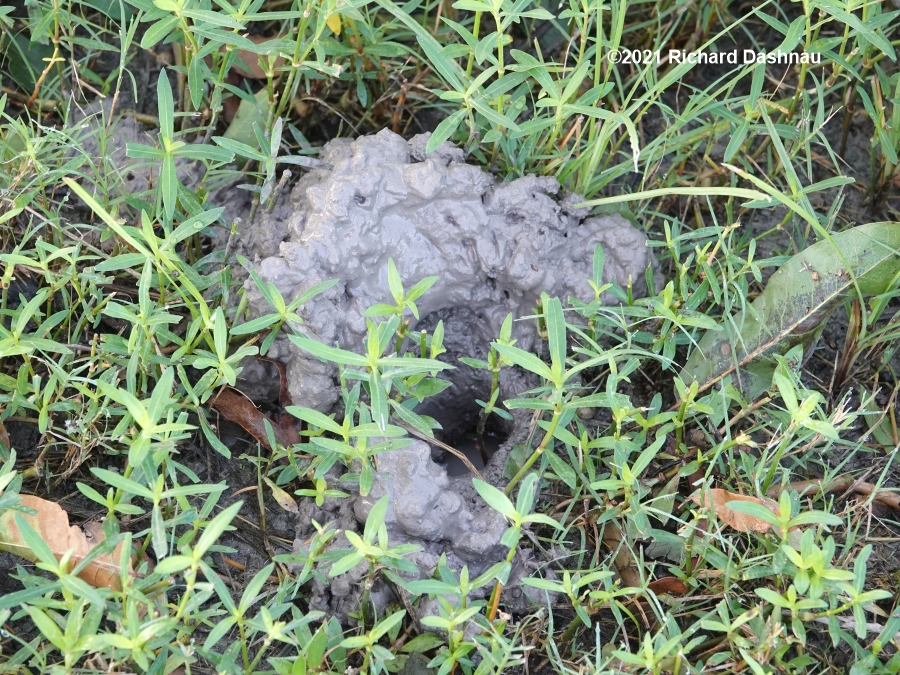
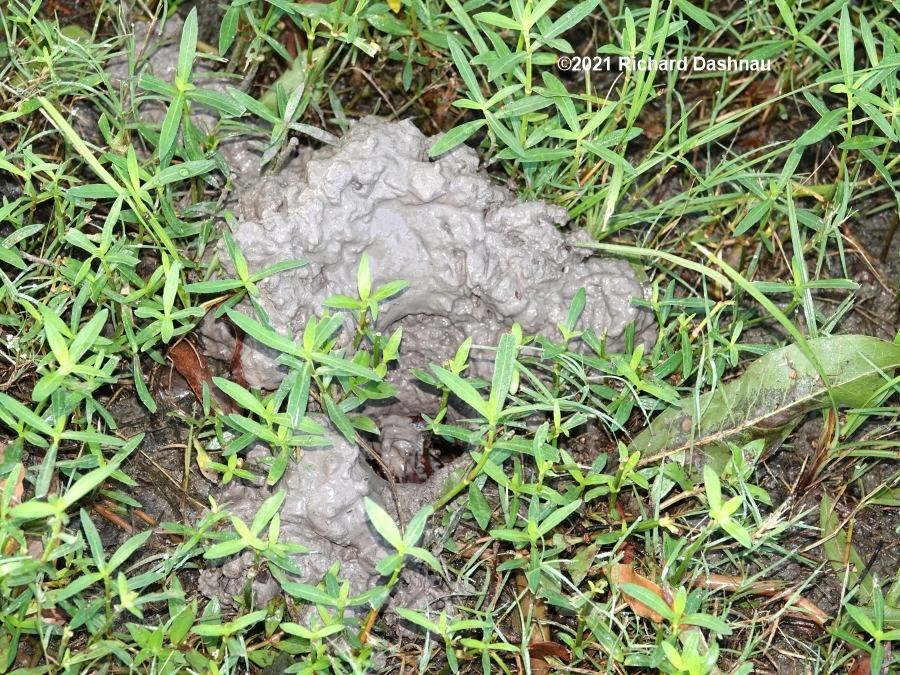
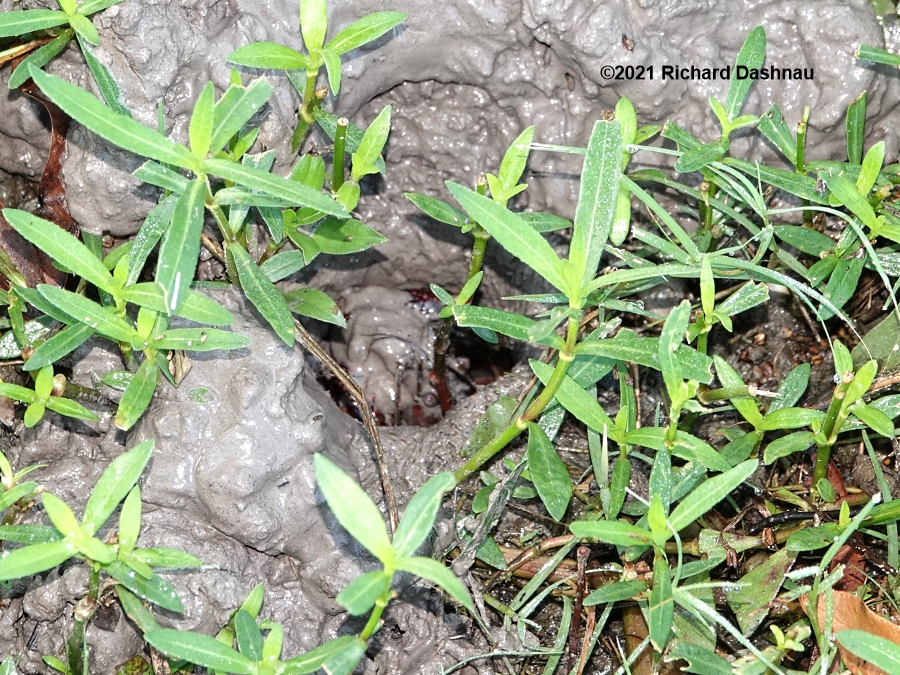
At Scobee
Field on 7/24/2021--The
ditches dried, though the dirt was still damp. I noticed a
snail shell
in a hole in the mud. Since I'd read about these snails can
aestivate,
I
took pictures of the shell before I moved anything. I had
already
seen many snail shells lying out of the water in other
locations, and
they'd all been empty(dead).
But
just in case, I took many pictures of this one. The
depression, or
hole, or whatever, was intriguing.
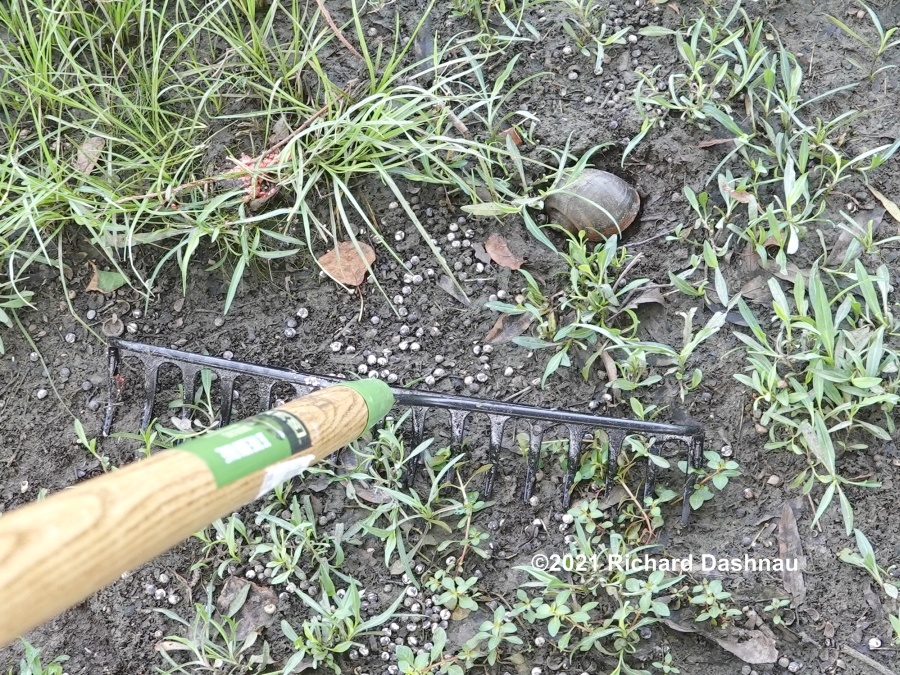
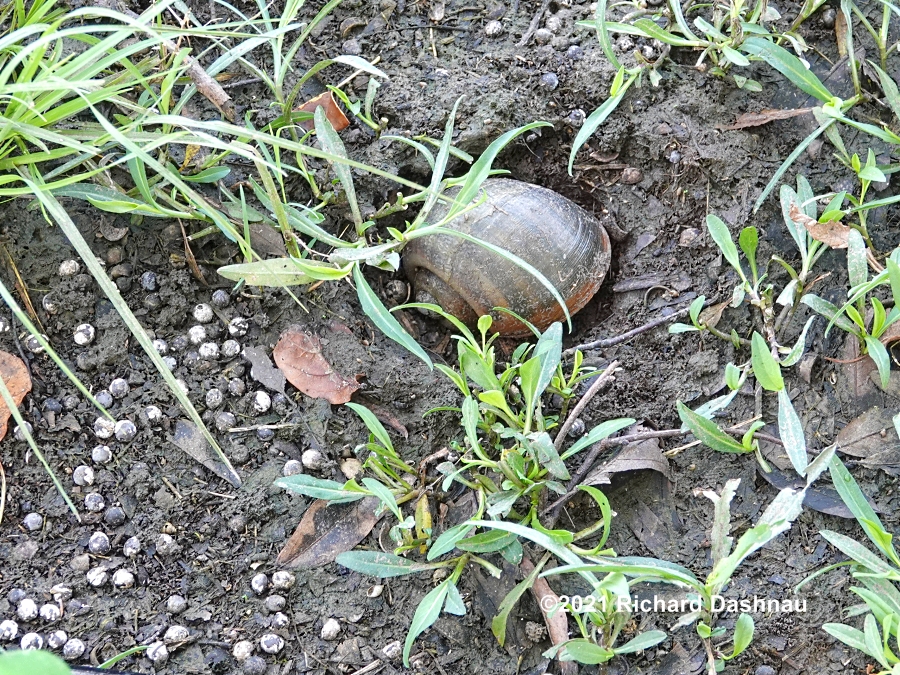
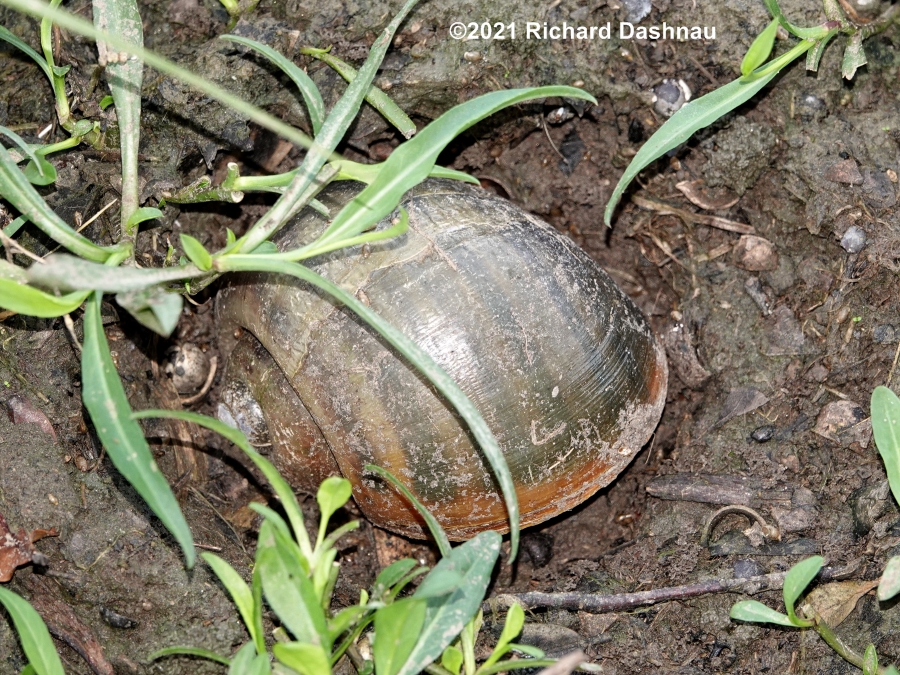
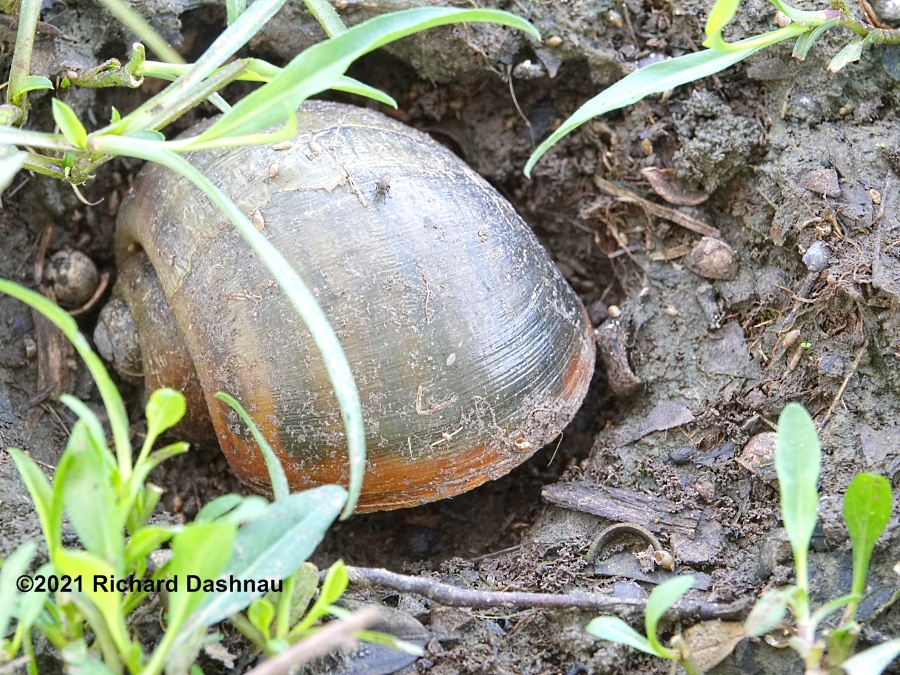
Snail in the dried ditch
Shells of dead small snails litter the area
Snail in the hole
shot with flash
Snail
in the hole shot
without flash
Then
I turned the shell over. The snail was alive! I
could tell
by the sealed operculum. I took pictures of the snail
and the
depression. The hole wasn't elaborate, but it seems
like
the snail
made it. As of this date (9/29/2021) I haven't found
any
description of how Pomacea aestivate naturally. Do they dig
burrows, or
dig anything? I've read of
one
experiment shows that it's possible for these snails to
survive TEN
MONTHS
without
water,
as long as they can maintain a seal to conserve internal
moisture. The snail had
"backed
into" the hole, so perhaps it could dig by manipulation of
its foot.
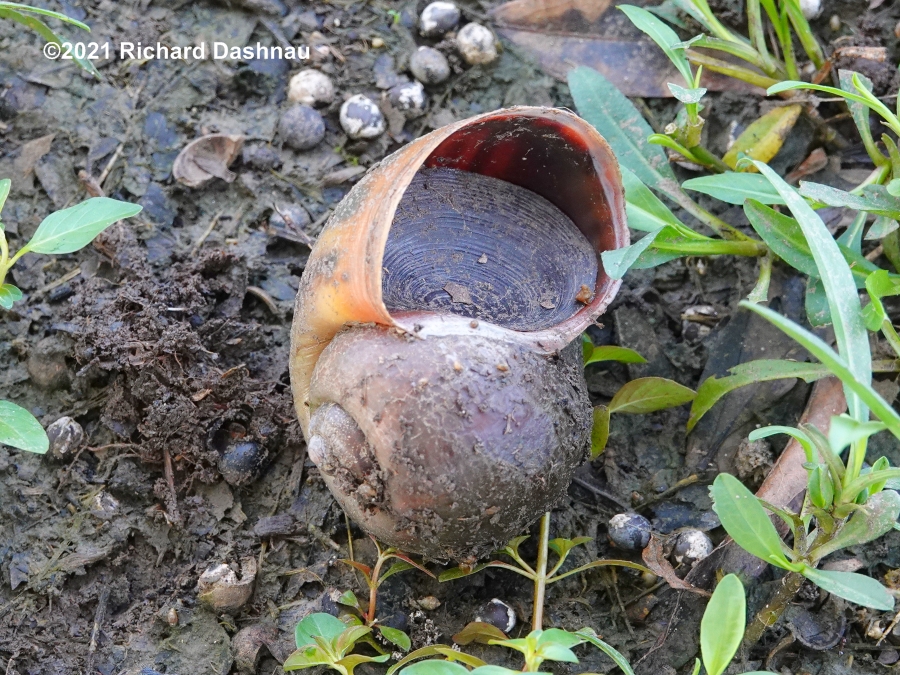
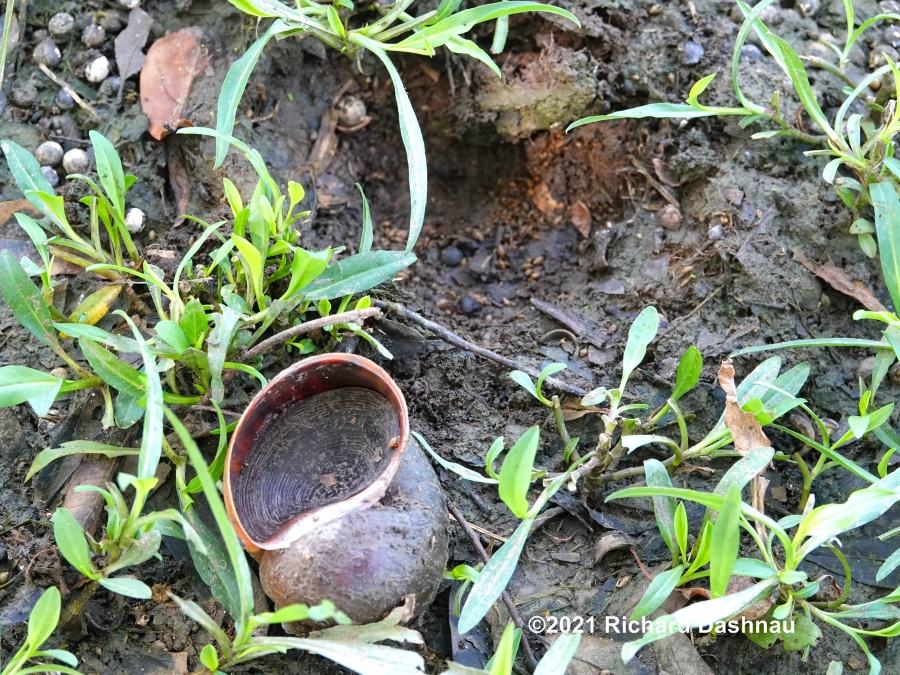
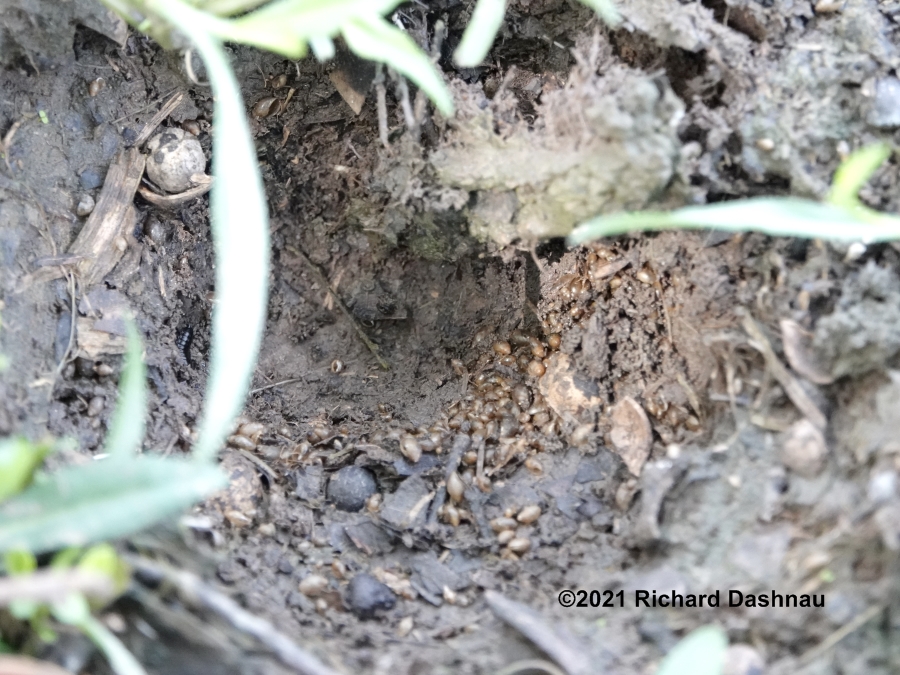
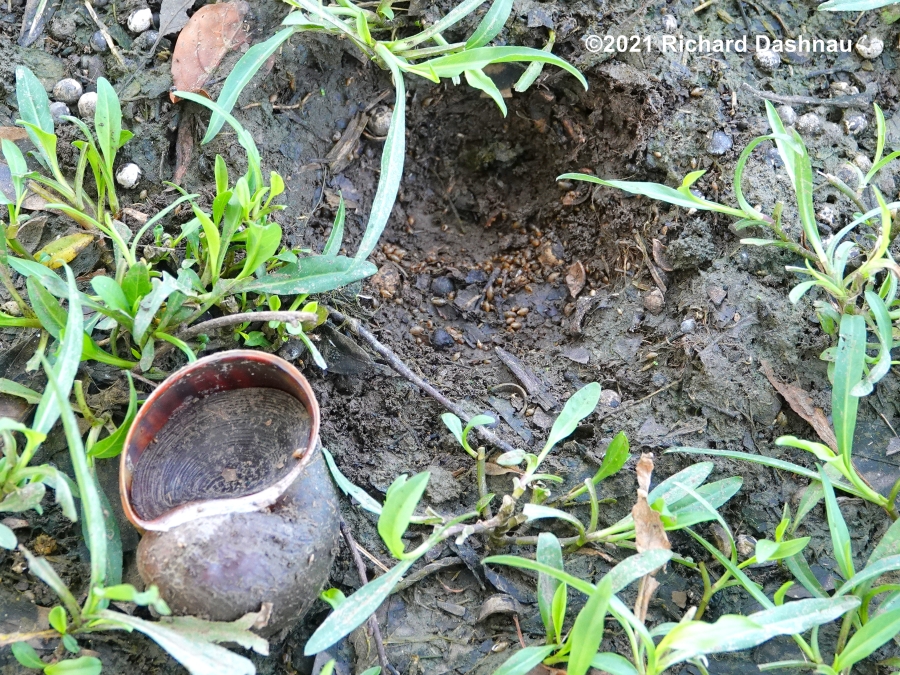
Snail flipped over. It's
alive!
Flipped snail next to the
hole
Closer view of
the hole
Snail near the hole,
view shifted a bit.
07/19/2021-
I
haven't been able to exercise in the area I normally use because it's
been raining. Today, it seemed like the circle had dried
enough
to use,
so I walked around it, clearing sticks and other items.
As I made another circuit, I noticed a round hole.
It was
about 1.5 inches (3.8 cm)across. It was much
too large to be a
cicada exit burrow. My first thought was that it had been a crawfish
burrow (Red Swamp Crawfish Procambarus clarkii) that had had
the
"chimney"
knocked off--perhaps by park mowers. I wasn't wearing my
glasses,
but as I stood above the hole and looked down, I thought there was
something
in there. I retrieved my glasses and a camera from my car,
and returned.
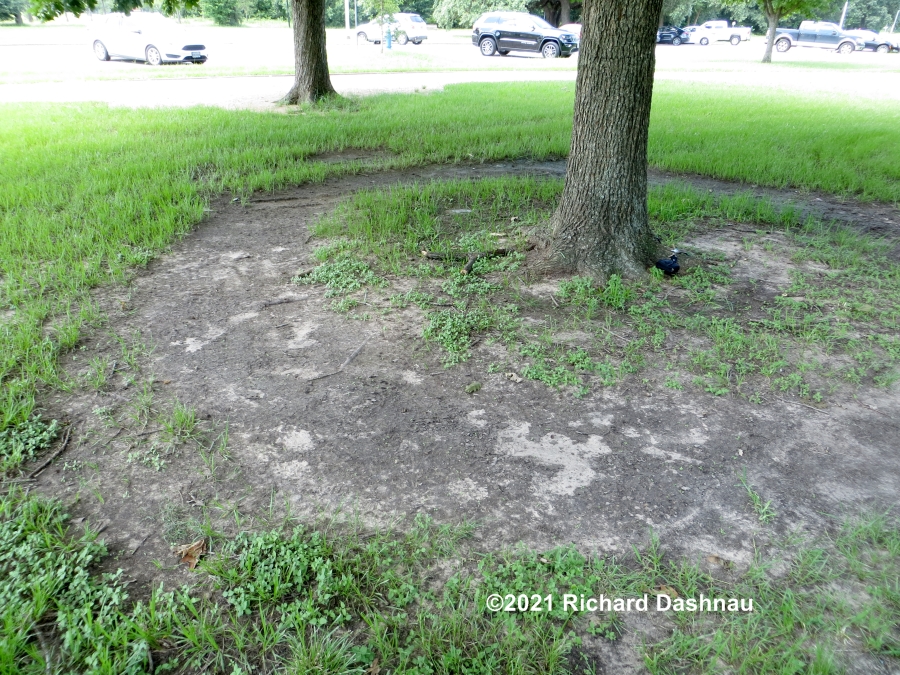
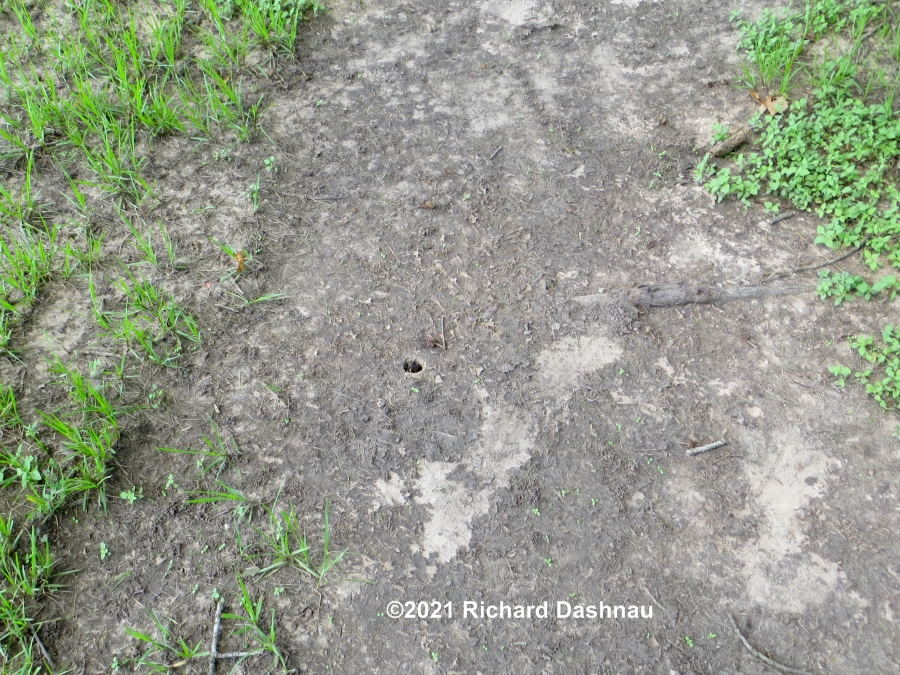
I
stood above the hole, this time wearing my glasses. I bent
and
looked down into it...and something moved. Then, a face
appeared
at the opening! It was a toad!
The little face looked up at me. I'm pretty sure that the
toad made that hole--probably as the water dried and of
course before the mud had hardened. I took
a few more pictures--giving the toad space so I didn't scare it.
Then, I moved my workout to the next tree over. In
the cropped images, I can see a blister at the front
edge of its mouth.
It looks a lot like fire ant blisters I've gotten. Poor little critter.
I've tried to figure out what kind of toad it is.
After
some searching, I've found that it's
probably a Gulf Coast Toad
(aka Coastal Plains Toad; Incilius nebulifer). I can't see the toad's
body, but those prominent bone crests between the eyes seem to be a
defining feature. I found the information in this: A review of the
biology and literature of the Gulf Coast Toad (Incilius nebulifer),
native to Mexico and the United States
by Mendelson, Kinsey et. al.
(Article in Zootaxa � June 2015 DOI: 10.11646/zootaxa.3974.4.4)
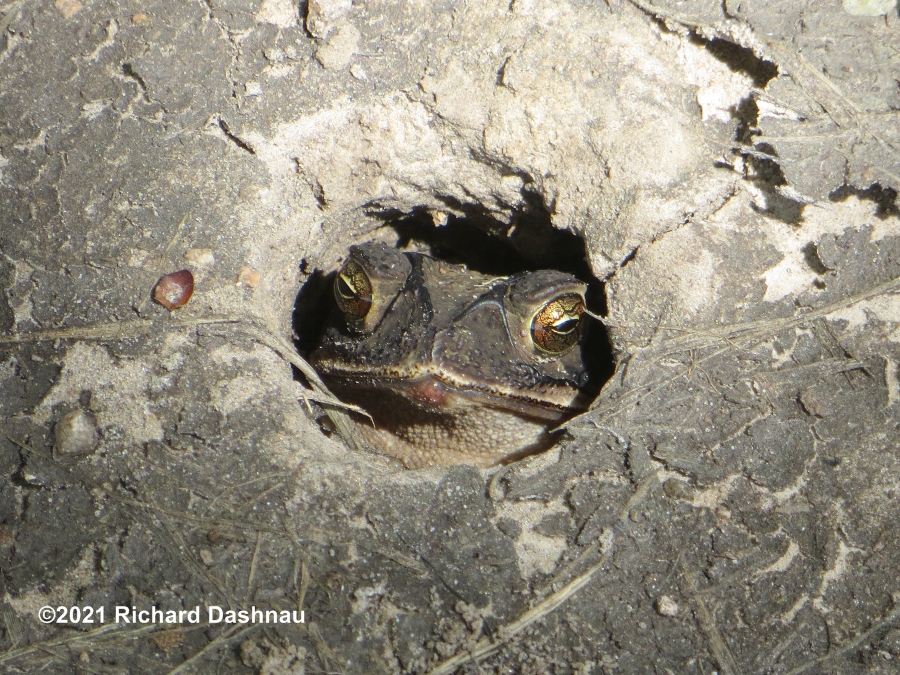
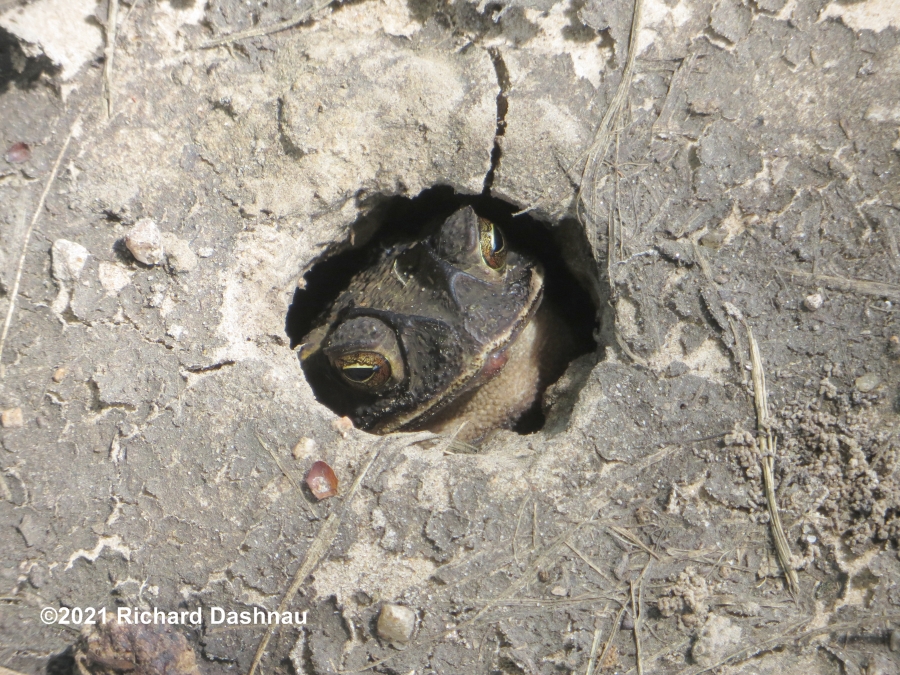
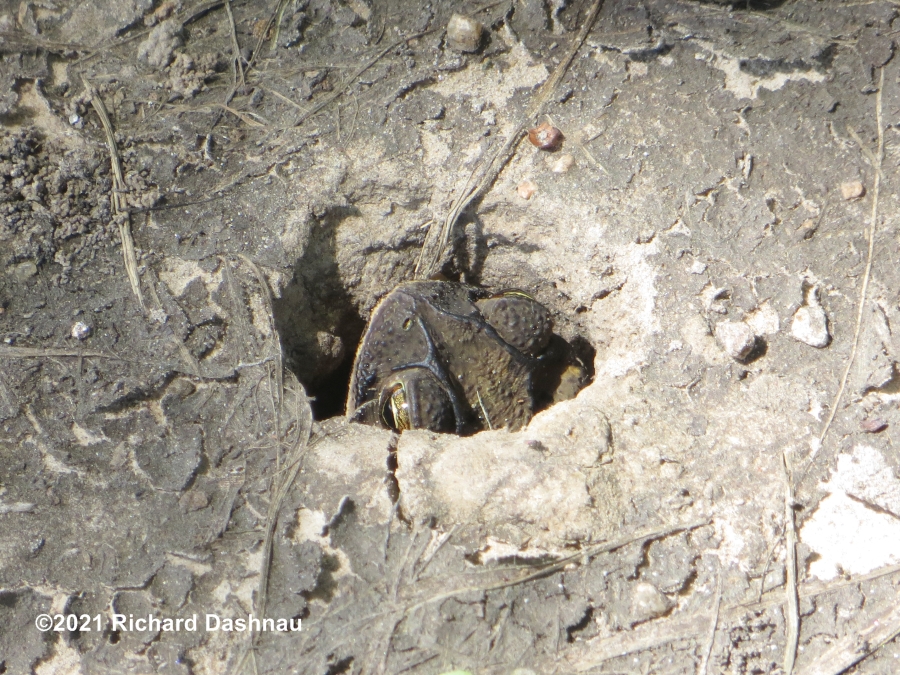
(update 07/20/2021)-
I returned the next
day--after all, it's where I regularly practice. I was sad
and a bit relieved to see that the
toad
had left. Relieved, because I thought that the toad was at
risk,
even in the hole. Since the toad had gone, I could examine the hole.
From
the top, the hole is about 3cm across (1.2 inches--I'd estimated 1.5
inches). I tried for pictures into the hole. It does have a
visible
bottom. That "ledge" is probably just a hard area in the
substrate that couldn't be burrowed through.
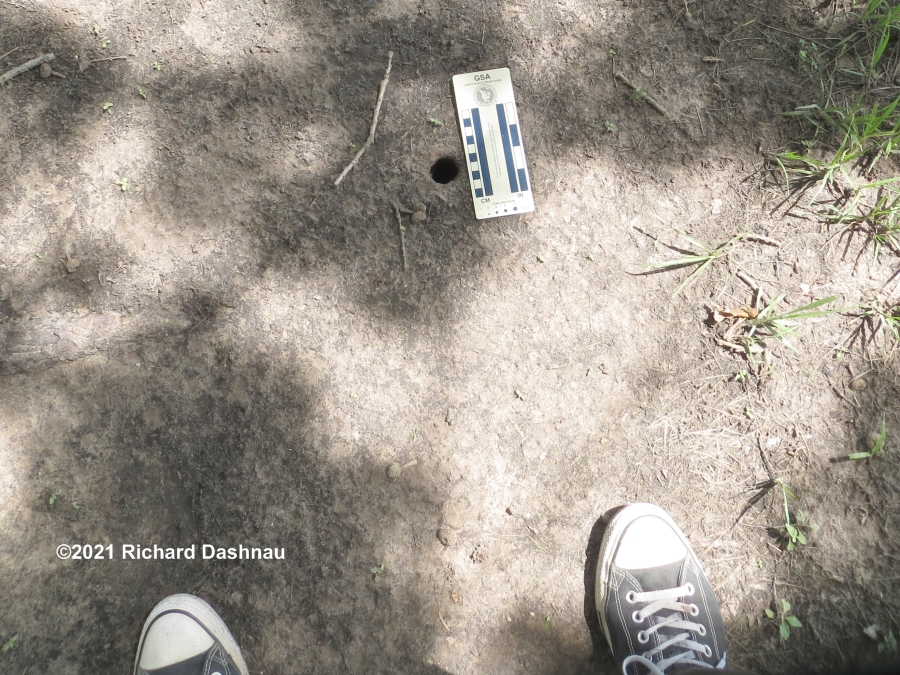
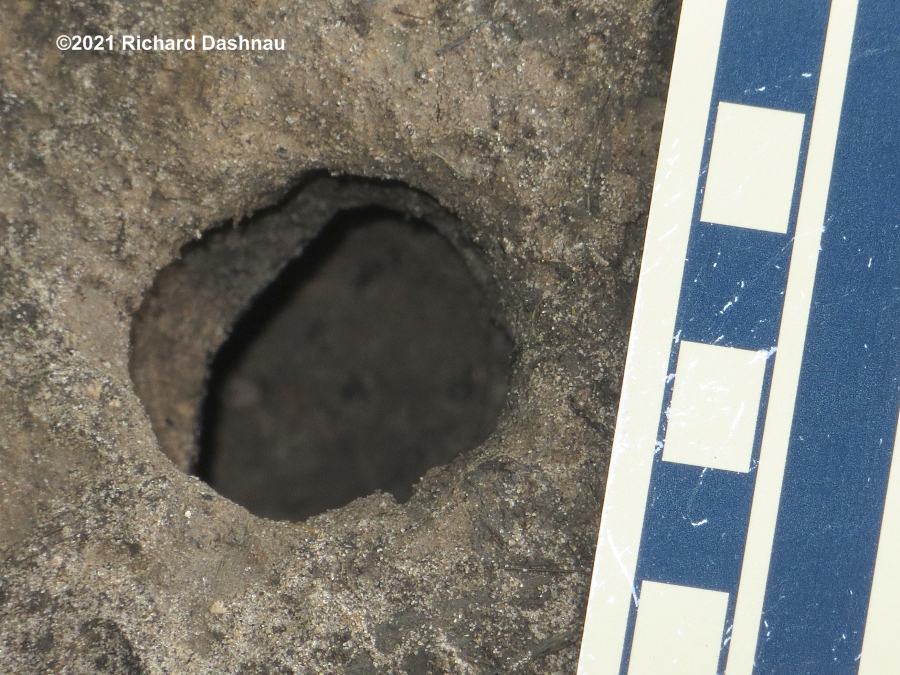
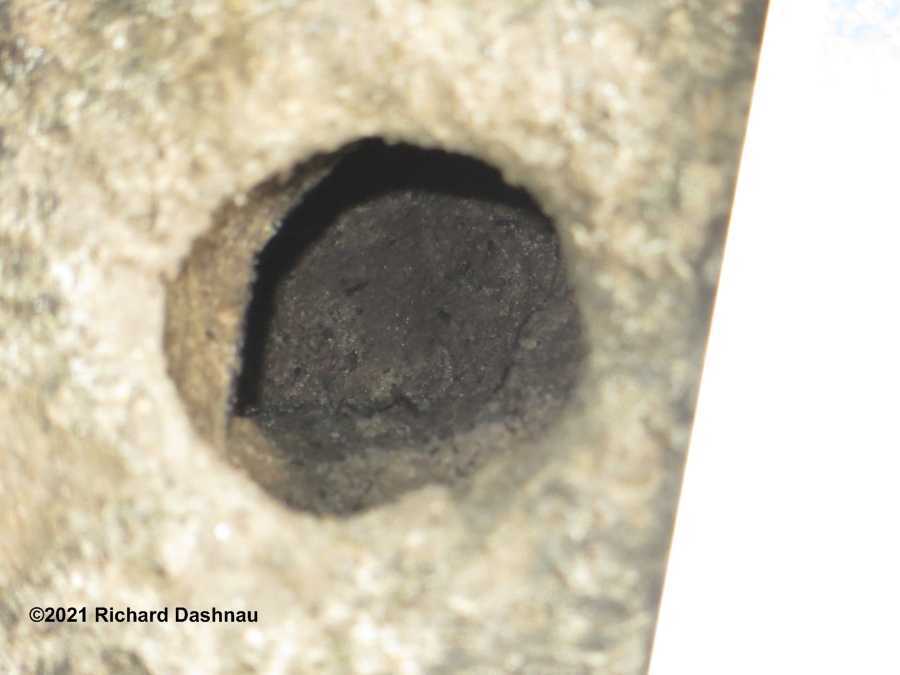
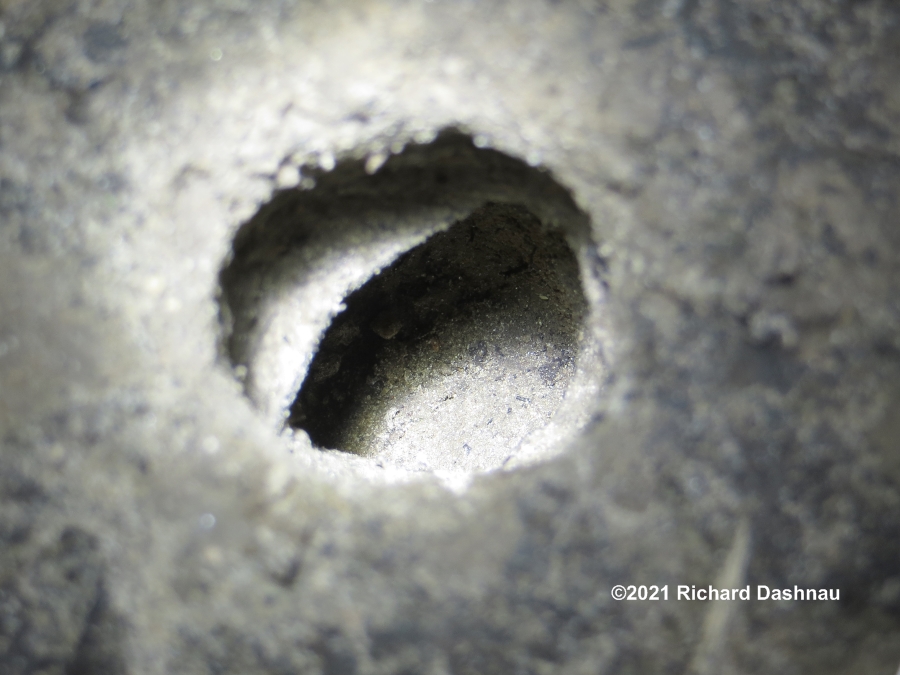
I
was able to see a bit more clearly into the hole than the images show.
So I thought it would be ok to probe a bit with my finger. The mud was
packed, not soft. Also, the narrow
parts are like shelves--that
is, the wall is the same width under it as over it. I
couldn't
tell for sure if the bumps were exposed tree roots. Also, the hole
stops at the bottom, and
does not turn in any direction into
anything horizontal. Finally, I made a "high-tech depth sounding
device" from a twig and placed it into the hole. I pinched it at the
top edge of
the hole, and then-holding by the pinched point-placed
it onto my gauge to get a depth reading. The hole is about 5
inches (13 cm) deep.
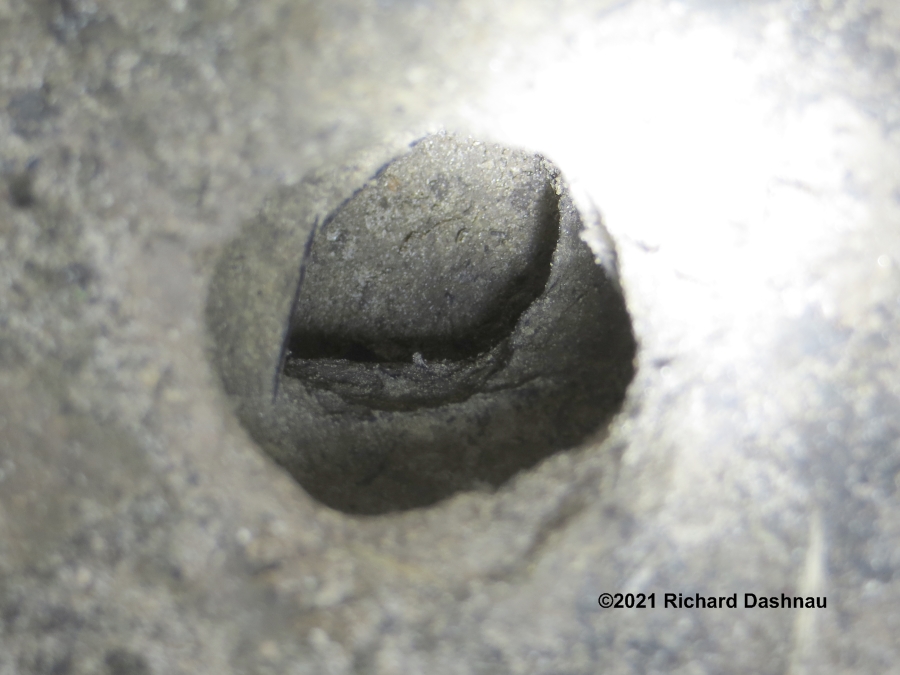
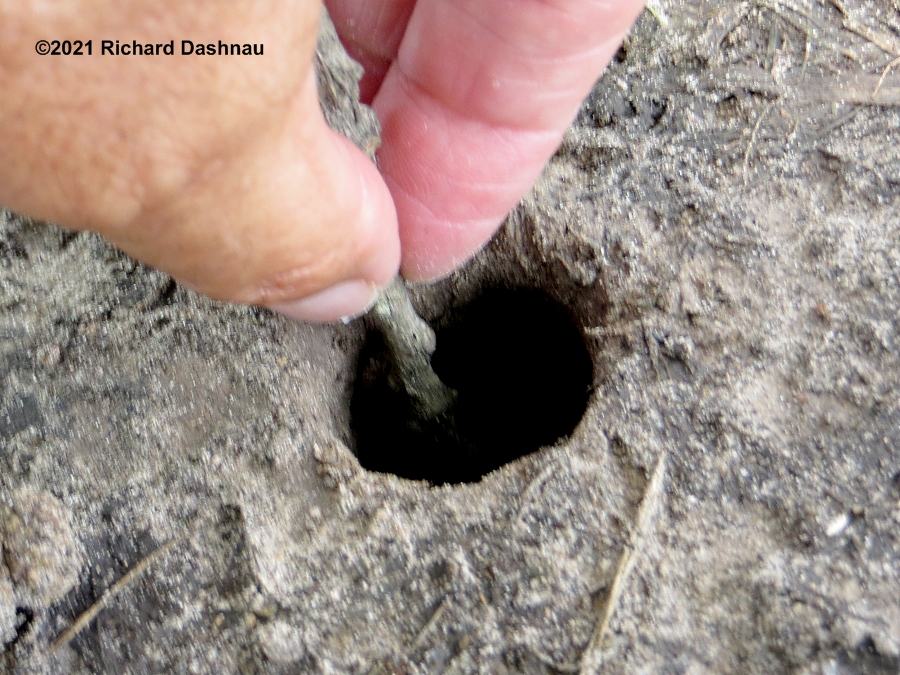
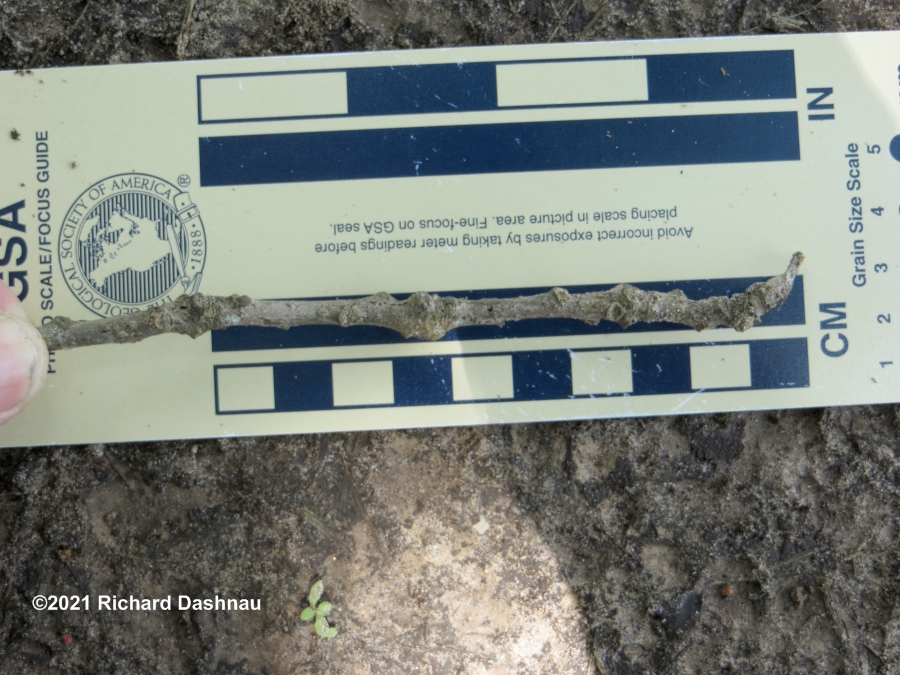
05/02/2021 Even
with more "spare time"
it's taking me days to work on new material so I can post it. Part of
the reason is that I get more
new material before I've completed
editing of the previous new material--because I have more of that
"spare time" to go get the new material. Oh, darn. LOL
So, here's how my morning went at Brazos Bend State Park on 05/02/21.
I have more
photos (and some video) but I need to post this now before much more
time passes (it's
already
been a week today). I'd just gotten to the edge of 40-Acre
Lake
(had just walked down the hill) when I noticed this set of animal
tracks on the trail. I'm a bit confused
on what made them. I
think they're from a cat because of the short heel pad and outline; but
it look like there are claw impressions and a single "lobe" in front
and two "lobes" in
back--which would make them dog tracks.
Whatever they are, it looks lke they walked on top of the
human
tracks. I'll alter this description pending any expert input.
If
they are
feline
tracks, then they'd probably be from a Bobcat, which would be pretty
cool. (UPDATE)--Alas.
According
to a number of experts, my
second guess was correct. They were
dog
tracks. Thanks to science
twitter folks: Dr. Lisa Buckley (@Lisavipes) ; Dr. Anthony Martin
(@Ichnologist); Zachary Wardle (@ZacharyMWardle).
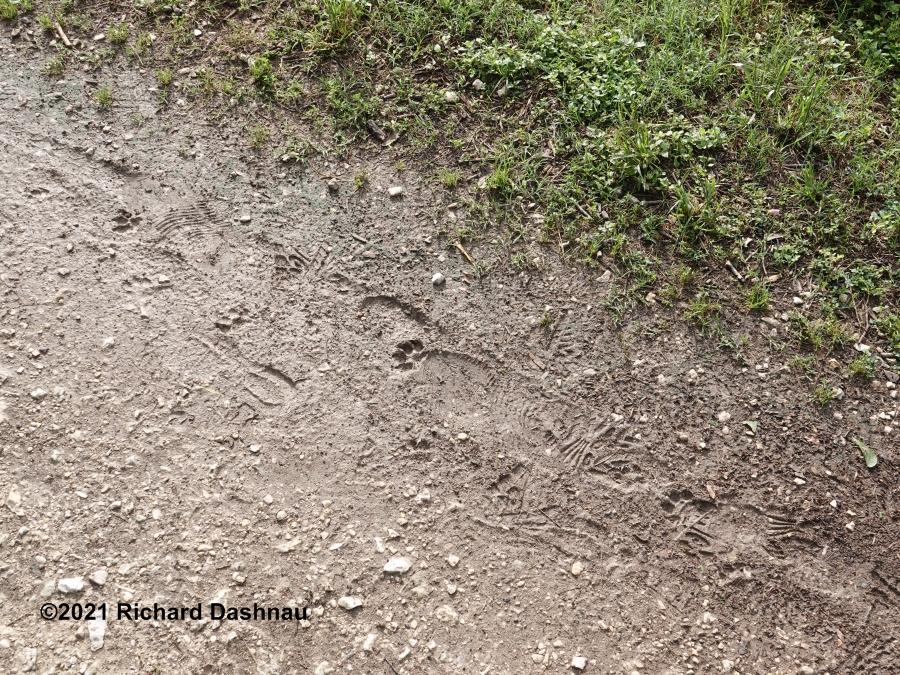
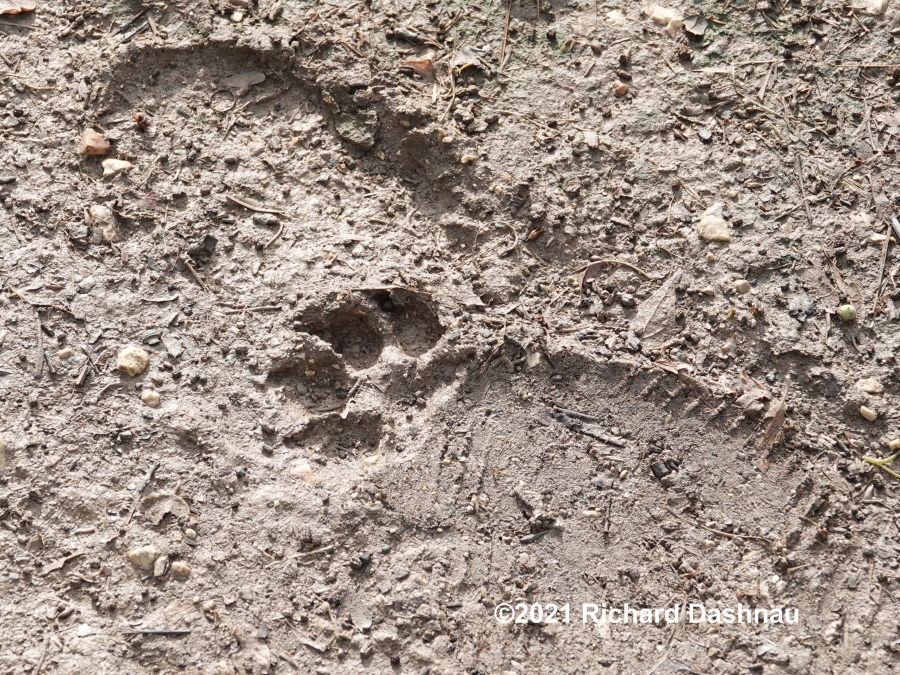
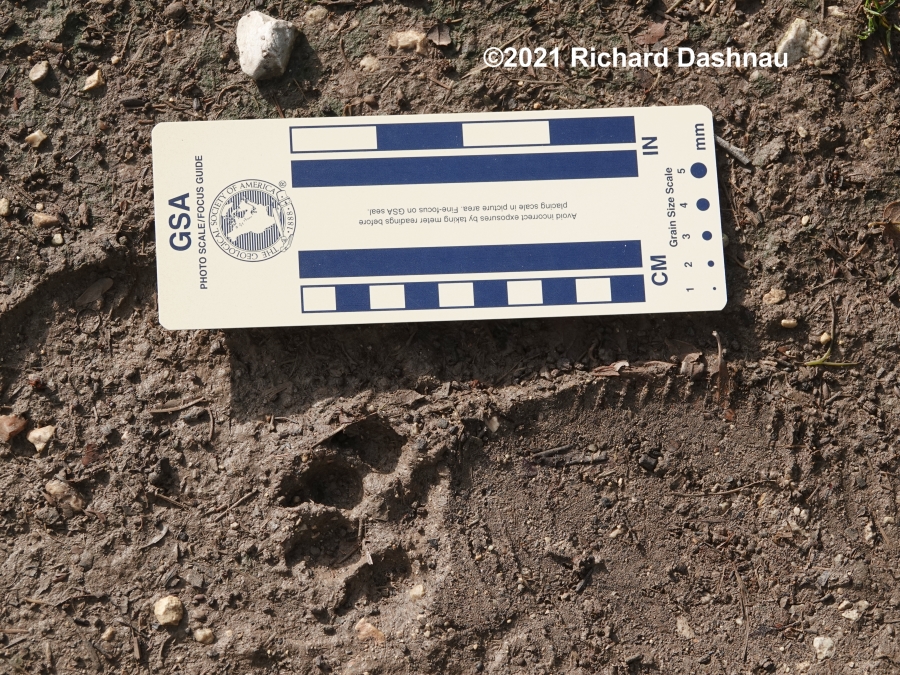
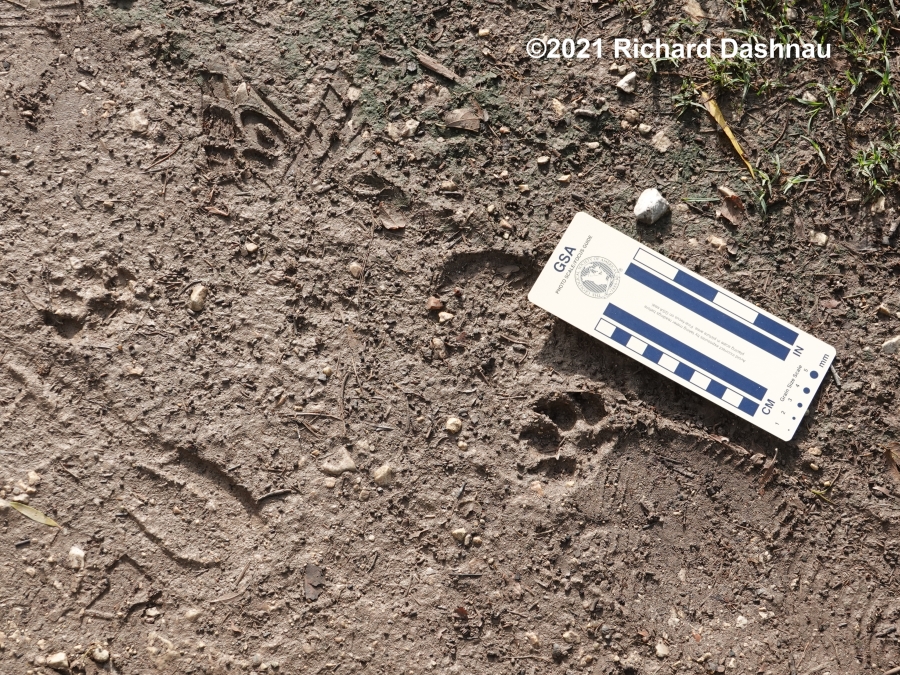
Animal
tracks!
Go to
Ichnology
page 1.
Go to Ichnology
page 3
Go to Ichnology
page 4 (this has the most recent observations).
Go
back to my home page, Welcome
to
rickubis.com
Go
back to the RICKUBISCAM
page.
















































































